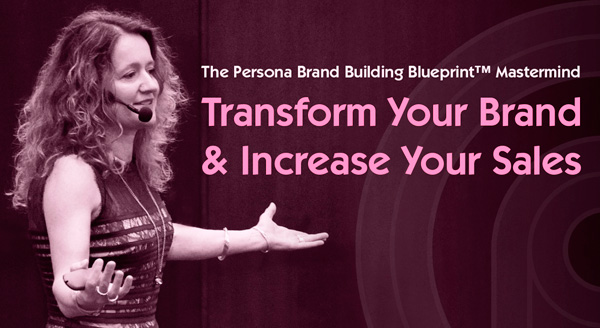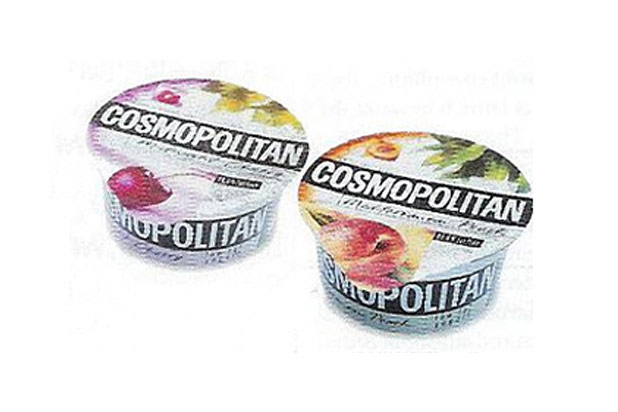7 Ways A Brand Refresh Will Make You More Productive And Increase Sales
/0 Comments/in Brand Refresh, Brand Relaunch, Brand Relevance, Brand Revitalisation, Brand Strategy, Branding, Rebrand, Rebranding, Return On Investment, Revamped Design, Revitalized Design /by Lorraine CarterIt’s often human nature to resist change because persisting with the comfortingly familiar feels ‘safer’. Sadly the marketplace is littered with case studies and examples of once very successful brands now gone forever, often because their leaders didn’t implement the critical changes needed, together with a brand refresh, that were essential to ensuring a successful future.
“A Business That Doesn’t ChangeIs A Business That IsGoing To Die”Frank Perdue |
The most recent example of this kind of demise is Stuttafords, a 159-year icon leading department store in South Africa, which will permanently close its doors at the end of July 2017.[1]
Another example is Sears, America’s previously largest retailer. It was a mistake their leaders made to assume no one could overtake them, and yet both Walmart and Amazon have. Sears failed to adapt and as a result, in June 2017, closed yet another 72 stores.[2]
Related: How Do Challenger Brands Become Market Leaders?
Both Stuttafords and Sears could still be flourishing today if they had been more open to real change and the sad fact is, to quote Buckminster Fuller, “You never change things by fighting reality. To change something, build a new model that makes the existing model obsolete” so a well-timed brand refresh underpinned by a thorough brand audit could have resulted in a very different story for both.
In this article, we’ll uncover the 7 ways a brand refresh could have prevented the downfall of some of the world’s greatest companies, to make them more productive so they could have maintained and increased their sales.
What Is The Meaning Of “Brand Refresh”?
A brand refresh means giving your core proposition a health check, using a brand audit, to identify where weaknesses, strengths and opportunities for innovation exist.
The findings can change the very foundation of a business, indeed the whole business model. It may have kept Sears, once the largest American retailer, and the doors of Stuttafords open.
For example, a brand refresh may mean a change in communication emphasis internally and externally, or a change in operations or perhaps an aspect of the brand story needs leveraging differently or the development of a whole new product or service is required to add a new revenue stream and meet customers’ needs. It may be that the company’s messaging, language and copywriting needs re-evaluation because it’s no longer relevant or appropriate to where the market has moved.
Related: Rebrand or Refresh? That is the Question
Refreshing your brand may even require a change at the very core of the business and what it stands for, and how that manifests in the organisation’s culture. What’s often misunderstood by many is thinking that a “brand refresh” entails cosmetic changes in the form of design only — that is a big mistake!
Changes such as design, video, photography, fonts, colour palettes and so forth should only be instigated as a result of much deeper strategic input where the brand has been fully evaluated, re-codified and mapped out for current and future market relevance.
In fact, nothing in the visual aspect of a brand should be touched or given a visual refresh until the strategic rationale behind that change has been fully developed in depth because it’s the outputs from that process that informs and provides much-needed direction for a design change. |
Approaching your brand refresh in this way ensures a successful result and strong return on investment while also avoiding decisions based on uninformed subjective preferences.
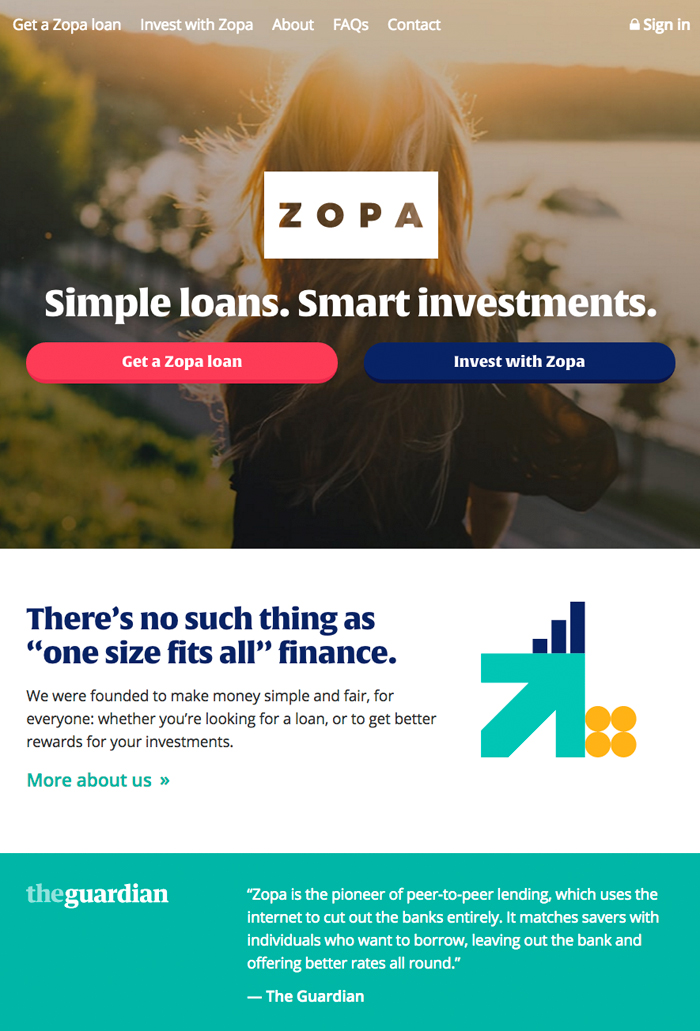
Image via Zopa
Zopa, a UK based company founded in 2004 and consisting of approximately 200 staff members, was the first peer to peer lending company, and provides clarity on what “brand refresh” entails:
Related: The Power of Disruptor Brands and Challenger Brands
Family Business Branding and The Secret Drivers to Brand Success
/0 Comments/in Brand Personality, Brand Relevance, Brand Reputation, Brand Strategy, Brand Values, Customer Engagement, Entrepreneur, Family Branding /by Lorraine CarterAt his Tuscan estate overlooking Siena, Dr. Francesco Mazzei pours a glass of ruby red Chianti Classico while beginning to tell the story behind the distinctive label that represents several legacies: the name of his family’s medieval country house castle, the village hamlet, the family winery, and the year it was founded. “Castello Fonterutoli Mazzei 1435” wine is one of the acclaimed reds the Mazzei family has been producing for a remarkable 24 generations; in fact, in terms of family business branding, they’re one of the ten oldest family enterprises in Italy. Naturally, wine lovers are intrigued to hear more from the charismatic Marchesi Mazzei and eager to taste his time-honoured Chianti.

Image via Mazzei
Family Business Brands Drive the Economy
Family-owned and operated businesses come in all shapes, sizes, and ages. Yet they share the roots of a common attribute: quintessential authenticity. A family business brand has a distinctly personal voice and can uniquely build unparalleled trust. Trust underpins profitable brand growth because without trust customers won’t buy from you.
It’s critical to understand, whether your business is a family enterprise or not, branding is NOT marketing or design but the bedrock strategy supporting and directing your whole business so your brand strategy is fundamental to your business’s longevity and ongoing profitability.
Global management consultancies are wise to keep a keen eye on family enterprises. EY suggests that family business is the world economy’s “secret driver of success.” Their research library published a 2015 report undertaken with Kennesaw State University Cox Family Enterprise Center (Georgia, USA) indicating that: “The importance of family businesses to the global economy is undeniable. They account for more than two-thirds of all companies around the world, many of which are household brand names, and 50%–80% of employment in most countries.”[1]
At the KPMG Family Business Practice Global Think Tank, the group’s CEO for France explains, “It’s a philosophy, it’s a spirit, it’s a backbone of our economy.” [2]
“Before the multinational corporation, there was family business. Before the Industrial Revolution, there was family business. Before the enlightenment of Greece and the empire of Rome, there was family business.” – William T. O’Hara, author, “Centuries of Success |
We’re all busy so building the bedrock brand strategy supporting and directing your whole business to ensure it’s growth and sustained longevity may not be your top skillset. If you’d like professional branding input and want access to a detailed overview of what’s key in the brand strategy context to grow your business then get in touch? Alternatively book one of our transformational workshops, brand building intensives or masterclasses.
The Persona Brand Building Blueprint™ Mastermind empowers you to build your brand strategy, raise the visibility of your brand, reduce customer acquisition costs and position your brand as the №1 choice for your customers.
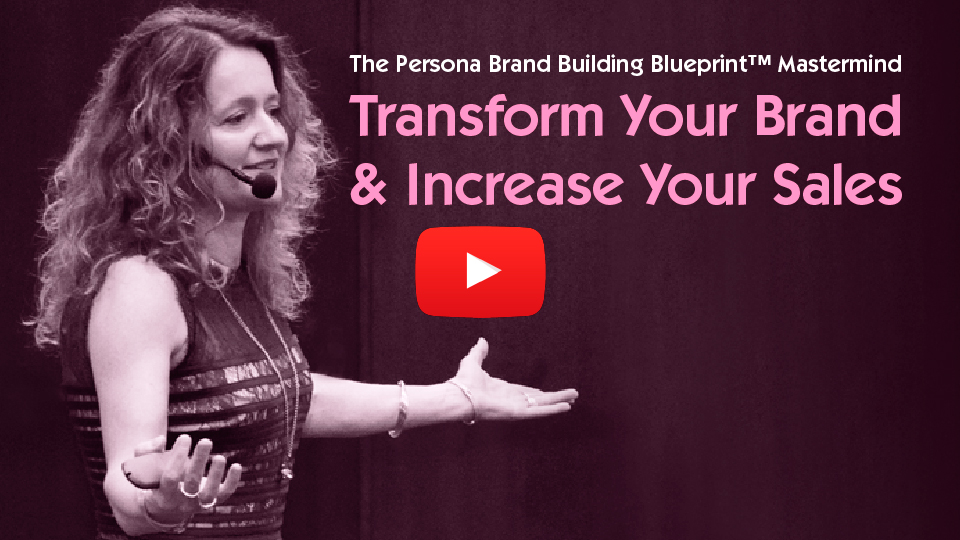
Build your standout brand at the Persona Brand Building Blueprint™ Mastermind with Lorraine Carter
Family Business Branding Has a Lasting Brand Message
“From our family to yours…” is a strong, positive, relatable and emotive message. Family businesses are proud of their companies and their families, with 76 percent of those reporting in the EY study saying they refer to themselves as a family business in advertising, websites, social media, press releases and other promotional material and brand collateral. [3]
Related: Design Is NOT Branding: 10 Things Every Business Owner and Entrepreneur Should Know
Nothing is more enduring as a family business than two hospitality examples from Japan. Zengoro Hoshi is the 46th generation boss of The Hoshi Ryokan, a traditional Japanese inn established 1,300 years ago.

Image via 663 Highland (Wikimedia CC 2.0)
The world’s oldest hotel is run by Fujiwara Mahito, the 52nd generation descendant to manage Nishiyama Onsen Keiunkan since the year 705, beside hot springs where travelling samurai and Shogun once stopped to refresh.[4] In an interview with the KPMG Family Business Think Tank, Hoshi explains that both the family and the business core values are seamlessly expressed and impressed, “instilling the simple business motto in each new generation.”[5]
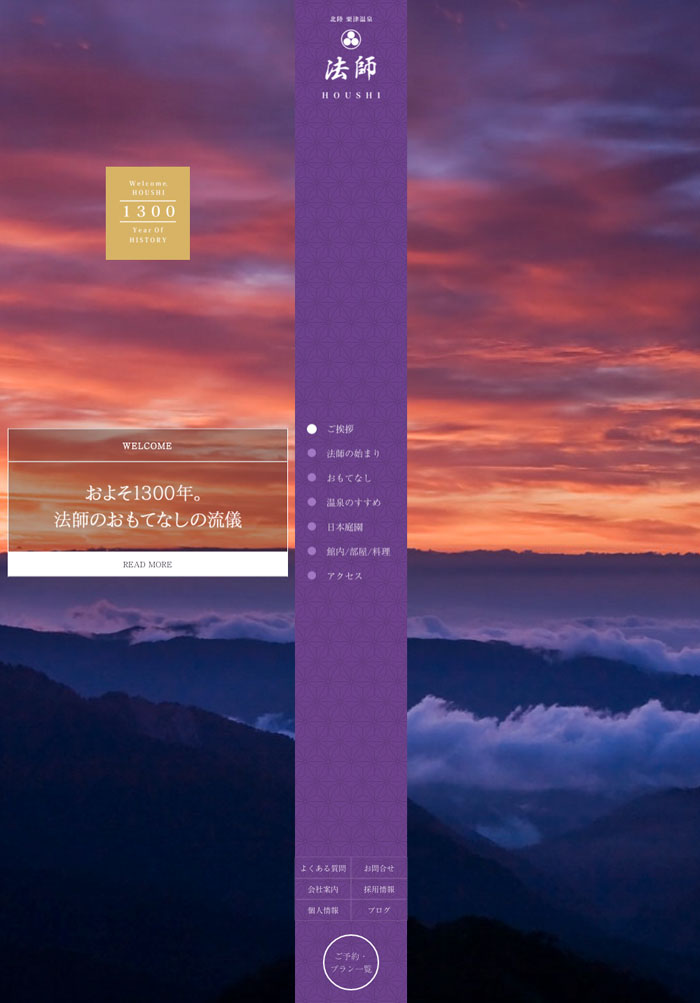
Related: 7 Powerful Components Of A Lasting Luxury Brand
When success breeds success and astronomical growth and wealth occur rapidly in the span of one lifetime, keeping customers connected to core brand values is a strong message that the founder can embrace and project. Two powerful examples of self-made 20th-century patriarchs are seen here:
Family Business Branding Through Their Founders Can Embody Authentic Brand Values
1) IKEA – From humble beginnings, one of the world’s wealthiest individuals is the 90-year-old founder of the largest furniture store group on earth, as well as the second-largest charitable foundation. He eschews the trappings of wealth, living in his boyhood rural Älmhult municipality, where IKEA headquarters is located.
Related: Social Responsibility: How to Build a Socially Conscious Brand
As a boy, Ingvar Kamprad bought matches in bulk from Stockholm to re-sell via bicycle in the vicinity of his parents’ farm, Elmtaryd, in the small Swedish village of Agunnaryd. As a teenager, Ingvar expanded into seeds, pencils, wooden Christmas decorations and more items. Working at the kitchen table, he named his little enterprise IKEA, combining his own initials plus the farm name and the village name.
In the autobiographical “Leading by Design: The IKEA Story,” and in the resource “Ikea Bible,” founder Kamprad has emphasized that “wasting resources is a mortal sin at Ikea.”[6] In his years at the helm of the budget-focused retailer, now run by his son, Kamprad pursued management by example, that is, emphasizing cost control. He has spoken of shopping post-season sales, flying economy class, driving a 20-year-old Volvo and encouraging staff to use both sides on a piece of paper.[7]
2) Berkshire Hathaway – Another farm kitchen table entrepreneur empowered by his bicycle, a young Warren Buffett sold chewing gum, Coca-Cola bottles, and weekly magazines door-to-door in his native Omaha, Nebraska.
Ever thrifty at age 86, Buffett is currently ranked as the world’s third wealthiest person[8], the legendary investor is grounded and approachable. He pays himself a modest salary of $100,000 annually and still lives in the Omaha home he purchased for $31,500 in 1958.
A voracious reader, Buffett practices his brand philosophy, frequently sharing advice with groups of college students to remind them that the best thing they can do is develop good qualities and habits early.[9]
Family Business Branding Creates Meaningful Brand Differentiation
Nobody can weave a more engaging, authentic brand story than a family business, and this is key to one of a brand’s eight pillars: differentiation. The perceived distinctiveness of the brand instantly separates a family brand from its competition. These brand pillars are fundamental to success regardless of your brand sector, B2B or B2C — which has also been abundantly evidenced by our experience in working with small and large family businesses nationally and internationally.
Related: 4 Reasons Why Your Business Profit Starts With Your Brand Mission
How did a first-generation pioneer build a company from nothing to pass on to the next generation? What was the initial spark of an idea? These are the stories that inspire pride and loyalty among employees, customers, suppliers and the local community. Such wonderfully curated (and honest!) anecdotes can be as juicy and delicious as your grandmother’s time-honoured recipe for apple pie.
If birthright or marriage has made you lucky enough to inherit a family brand, or if you aspire to achieve a highly recognisable, memorable — and loved — brand name, our Personality Profile Performer™ Programme shows you how to build your brand so you become, or maintain number one place in your market — how to enhance your brand relevance and improve your profits.
Also, times flies and we are aware that family businesses must be astute about strengthening, re-evaluating and leveraging brand relevance while training and managing succession and growth over the next 5, 10, 15-plus years. If you want in-person professional direction to re-evaluate your brand and would like professional input then drop us a line to [email protected] or give us a call T: +353 1 8322724 (GMT). We’d be delighted to talk with you.
Examples of Intimate Brands in SMB/SME Family Business Branding
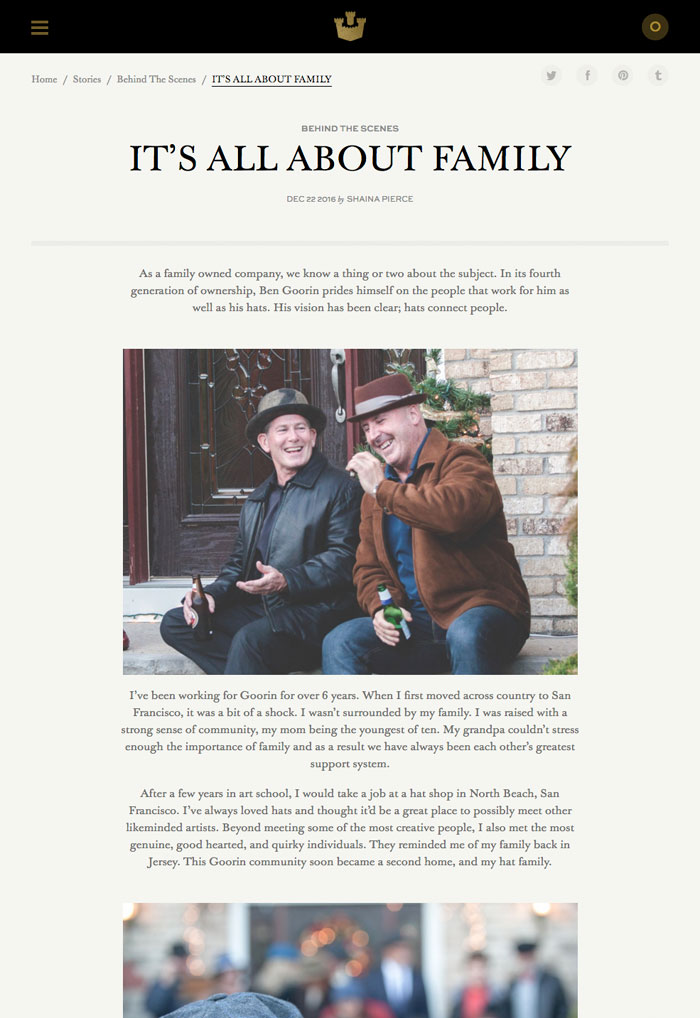
Image via Goorin Bros. Hatmakers
What We Love: Vintage sepia tones and modern fashion shots merge on this American hatmakers’ website. It’s sprinkled with historical anecdotes, providing interesting insights into the family brand established in 1895 (I know anything over a century is almost ancient, by American standards!) Goorin Bros. is painfully aware that hats are no longer the mandatory accessory they once were. The website relates the compelling story of brand survival and interprets the castle logo design.
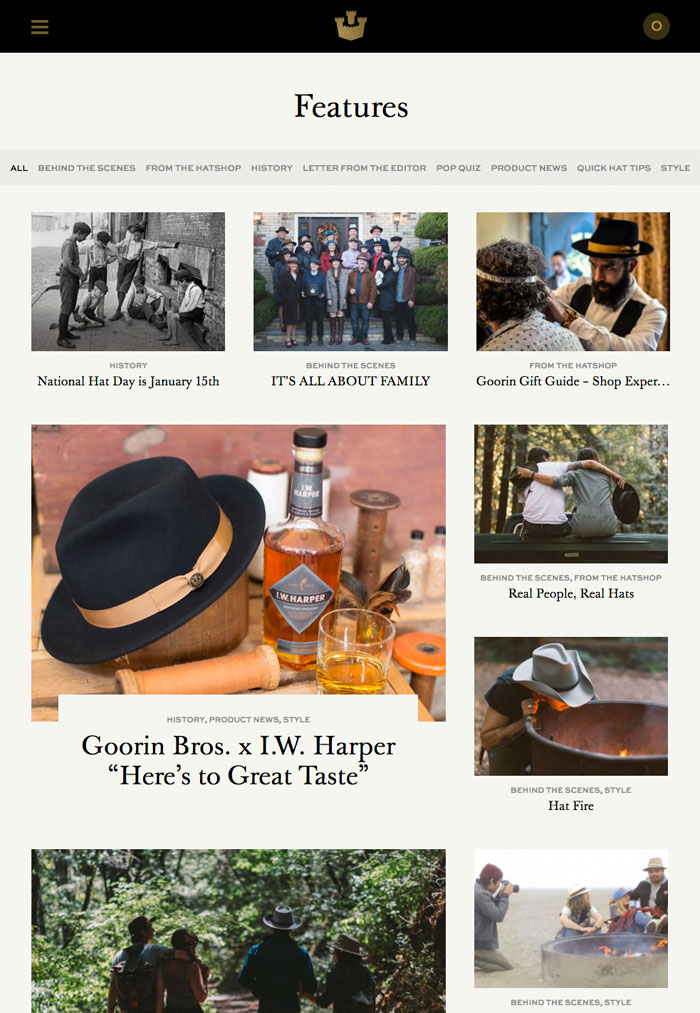
Image via Goorin Bros. Hatmakers
Takeaway: Cosy store interiors are decorated in vintage style, including an antique popcorn machine spitting out free samples, with highly personal assistance from the well-trained hat sellers.
Related: The Impact of Company Brand Culture On Driving Performance and Increasing Sales
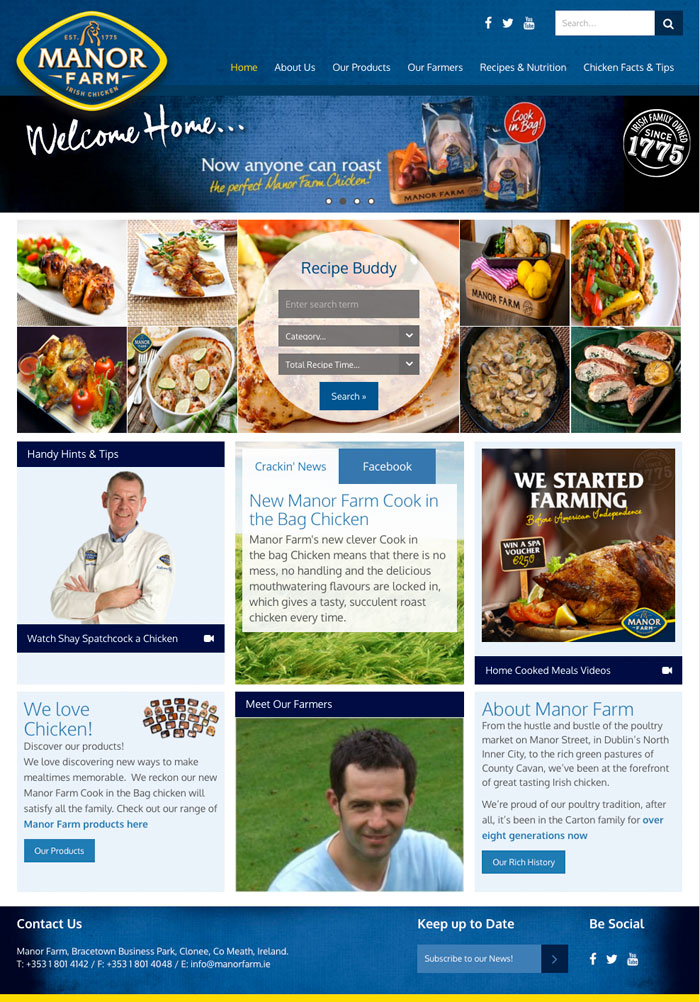
Image via Manor Farm
What We Love: More than 240 years later, one of Ireland’s oldest companies remains a family business. To establish an immediately personal connection to the brand, the website’s “Welcome Home” page features a seal of approval-style stamp reading “Irish Family Owned Since 1775.” It invites visitors for a glimpse behind the scenes to “Meet the Flock” of family farmer suppliers via their outdoor snapshots and to share the “Tasty News” recipe buddy.
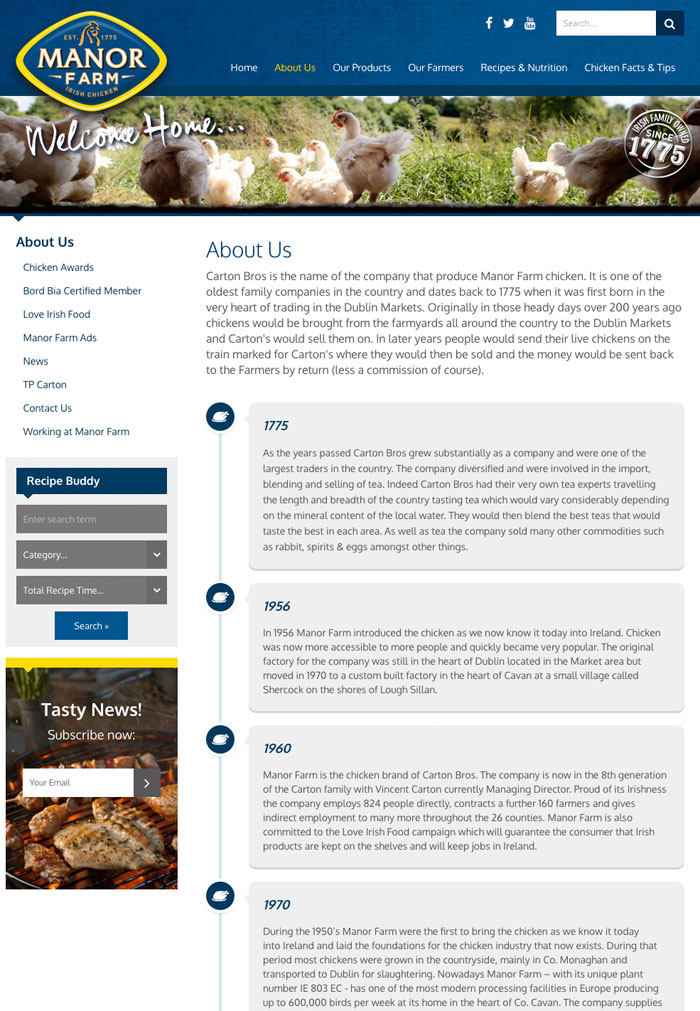
Image via Manor Farm
Takeaway: Manor Farms engages their B2B and B2C audiences by using humour. Chicken Facts & Tips includes Q&A such as “Are the chickens really Irish?” and “Can a chicken fly?”
Related: From Zero to Hero: How to Become a Must-Have Brand
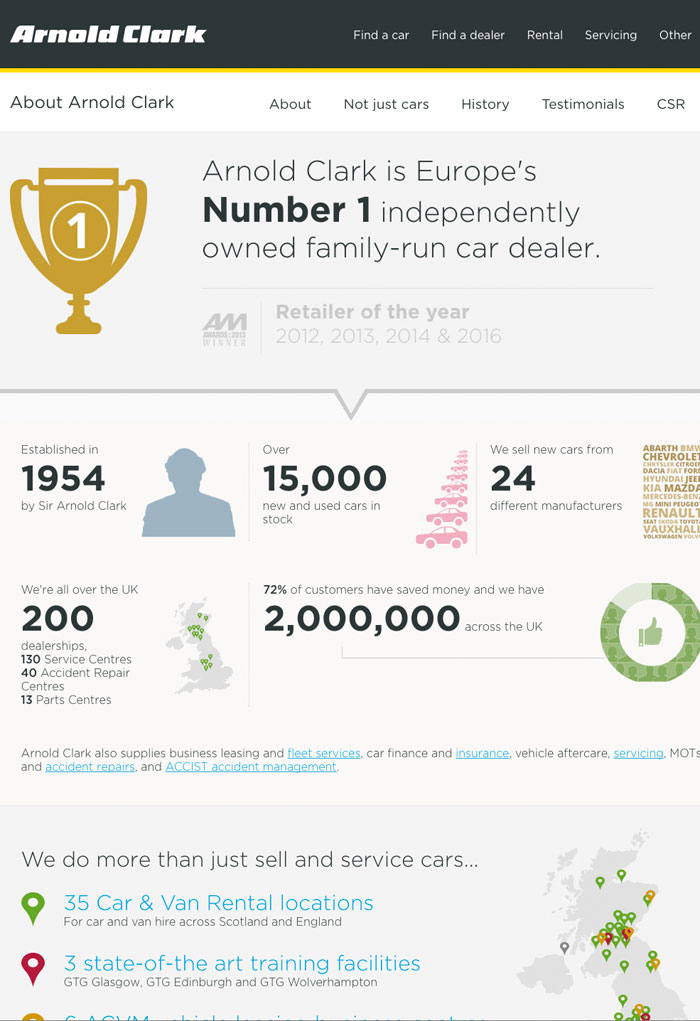
Image via Arnold Clark
What We Love: In 1954, Arnold Clark purchased a Morris Ten Four for £70 and, after many careful hours restoring the car to its original condition, sold it for a profit. The brand’s storyline is front and centre on the website where Arnold Clark proclaims itself “Europe’s Number 1 independently owned family-run car dealer.” One of Scotland’s largest companies, the family-owned firm run by its founder, whose story is a centrepiece for the brand. Sir Arnold is still in charge and has been joined in the business by his children and grandchildren.
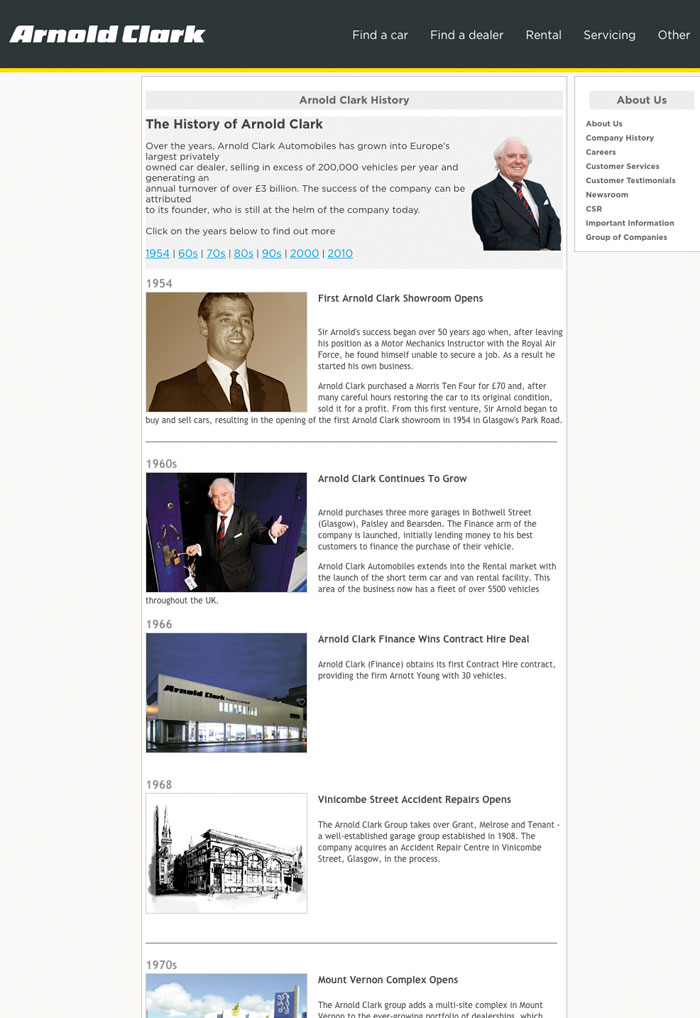
Image via Arnold Clark
Takeaway: The Arnold Clark testimonial page tells the story in the customers’ own words and leaves no room whatsoever for anything but strong assurances about the brand’s commitment to integrity.
Related: How to Develop Your Brand Tone of Voice to Increase Sales
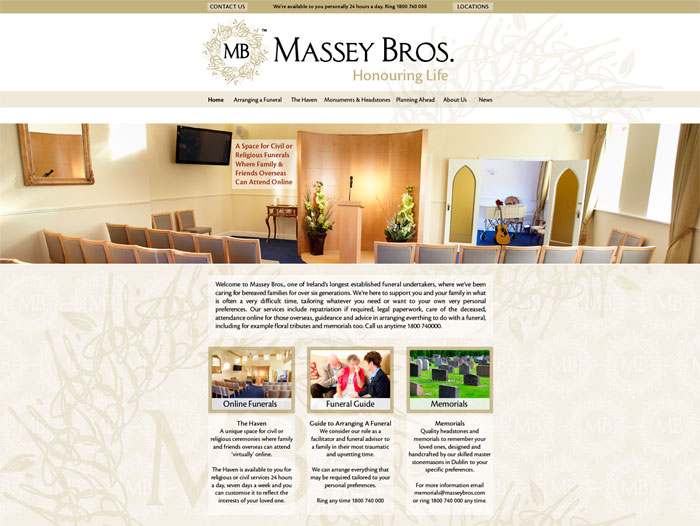
What We Love: Massey Bros. provide a really important service in one of the oldest services in society. They take care of you and your family in very distressing circumstances, the death of a loved one. They deal with death on a daily basis throughout the year. And yet their mission in dealing with death every day is to do whatever it takes to make the recognition and memory of your loved really special. Their mission is to Honour the Life of your loved one.
Massey Bros. is a business that can’t market itself like most others, they can’t overtly sell what they do, but they can share why they do what they do. Their purpose it what drives their big why and it’s one of the critical secrets to their success since the 1930s.
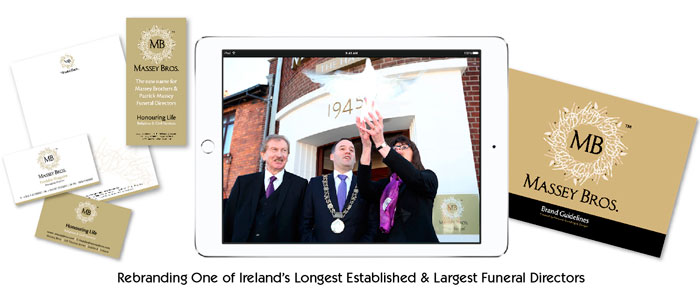
Takeaway: Testimonials that support the brand promise are featured throughout the website, which makes all the sense in the world in any business, especially one that requires utter all-encompassing care and total discretion.
Full disclosure: Persona Design worked with Massey Bros. on their brand revitalisation. You can read the case study here. In truth, haven’t worked with any other business which gets the amount of unsolicited thank you cards and letters that Massey Bros. get. They truly live their brand mission, like many other successful and very dedicated family businesses.
What We Love: The Sonderen tagline, “Packaging Solutions That Create Lifelong Customer Relationships” gets to the core of this family-owned B2B operation where we meet the second and third generation Mark, Matt, and Keva Sonderen, “Trusted Since 1963.” A complete folding carton manufacturer in Spokane, Washington USA, they do everything custom from design to finish, including inks, hard surface coatings, and die cut options.
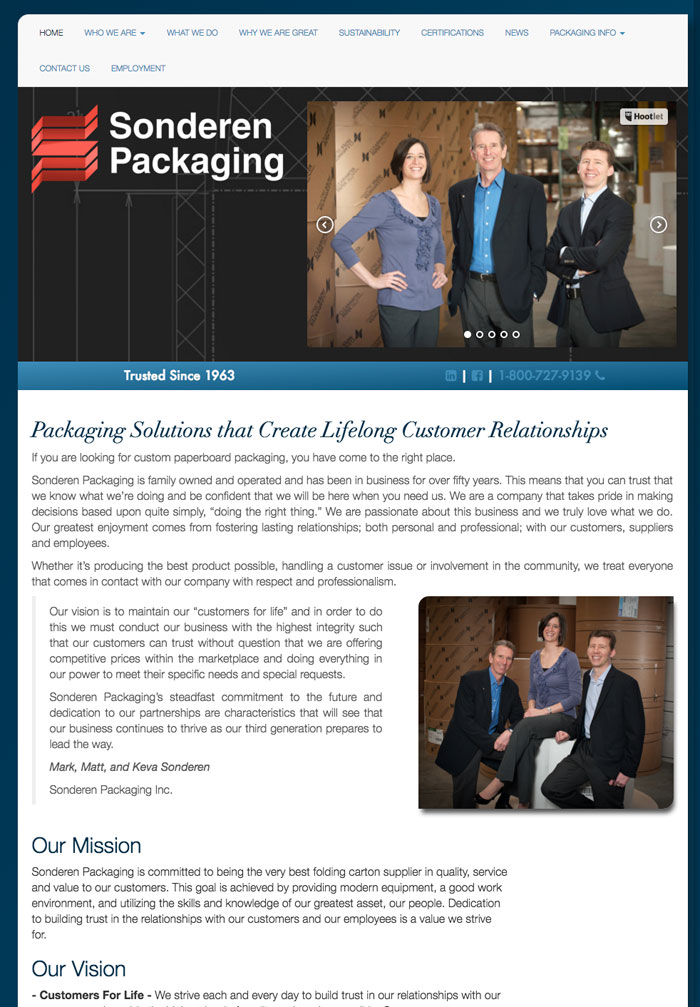
Image via Sonderen Packaging
Takeaway: A video, “Want to Learn More About Who We Are” presents the passion behind the business, its growth from 8 to 140 employees and its recovery from a devastating warehouse fire to achieve a customer retention rate above 95 percent.
Questions to Ask Yourself About Your Family Business Branding
- Have you identified your eight brand pillars and evaluated how they’re addressed from the customers and team internal perspective? These include elements such as your brand purpose, vision, values and personality.
- Have you developed passionate storytelling about your brand involving personal bits and pieces about family members that pertain to building the company and have those authentic story nuggets been shared congruently across all your brand touchpoints?
- Have you fully developed your standout brand messaging with its own unique personality, copywriting, language style and turn of phrase? Does your family business take full advantage of its brand messaging opportunities across all relevant brand collateral and media channels on and offline?
- Have you developed and displayed a proud history timeline in the proper tone of voice to suit your brand?
- Is there a cohesive branding message and visual language across every customer touchpoint, from website to logo, from uniforms, to colour palette and packaging, for example?
- Has the company story been shared with employees? Is it featured in all new hire training materials? Have your team been fully brand inducted and is ongoing training a part of your brand culture for ensuring cohesiveness, strong morale, innovation, growth and longevity?
[1] Global Data Points; Family Enterprise Statistics from around the World, Family Firm Institute, www.ffi.org/?page=GlobalDataPoints
[2] http://www.kpmgfamilybusiness.com/family-business-contributors
[3] http://www.ey.com/us/en/newsroom/news-releases/news-ey-family-business-is-the-world-economys-secret-driver-of-success
[4] http://www.atlasobscura.com/places/nishiyama-onsen-keiunkan
[5] http://www.kpmgfamilybusiness.com/worlds-oldest-family-inns-secret-succession
[6] http://www.forbes.com/profile/ingvar-kamprad
[7] Ibid.
[8] http://www.forbes.com/profile/warren-buffett
[9] http://www.forbes.com/sites/patbrans/2017/01/02/what-warren-buffett-and-ann-graybiel-advise-on-habits/#422723085d95
Brand Audits – How to Use One to Grow Your Profits
/0 Comments/in Brand Audit, Brand Auditing, Brand Audits, Brand Health Check, Brand Recall, Brand Relevance, Brand Revitalisation, Rebrand, Rebranding /by Lorraine CarterPerhaps you’ve seen some of the headlines. This one from Bloomberg pretty well sums up the lot: “Snoopy, Loved as Friend, Lacking as Leader, Gets Boot at MetLife.”[1]
Yes, after a 30-year run, MetLife is dropping Snoopy and the Peanuts gang. If you’re wondering why a company would break up a winning partnership and transform a brand that has worked for three decades, you’ve come to the right place.
While the decision to drop the iconic dog and his cartoon friends may seem capricious, you’ll see that, in fact, this is the case of a company that understands the critical connection between its brand and its business decisions. Markets change, new trends emerge, disruptive competitors alter long-standing rules and customer preferences evolve — all of which impacts your brand and consequently your business strategy.
Regardless of their size, companies that are trying to stay relevant, keep growing, expand their customer base, maintain high recognition and recall and convert awareness into greater familiarity are constantly wrestling with questions about their brands. And the most effective way to answer those critical questions is through a brand audit; see one of our previous posts entitled “Brand Audits: Why You Need Them and How to Perform One.”
Why is this important? Consider the findings in the 11th annual Accenture Global Pulse Survey: Once you lose a customer, 68% will not come back.[2] If better brand management can help retain more of those customers, then you need to invest the time, the thought and the effort into ensuring that your brand is delivering. And a brand audit is one of the most effective tools to measure and evaluate your brand performance.
“There is only one boss. The customer. And he can fire everybody in the company from the chairman on down, simply by spending his money somewhere else.”
Sam Walton
What’s in a Brand, and Why Brand Audits are Key to Growing Profits
If you want to evaluate your brand in terms of its capacity to deliver profits or return on investment (ROI), it pays to be ruthless in your analysis. In other words, take a page out of Forbes and its technique for assessing the value of a brand.[3] When compiling its annual list of Most Valuable Brands, the magazine’s analysts focus on the numbers — not “fuzzy consumer surveys” — and the ability of the top brands to generate revenue.
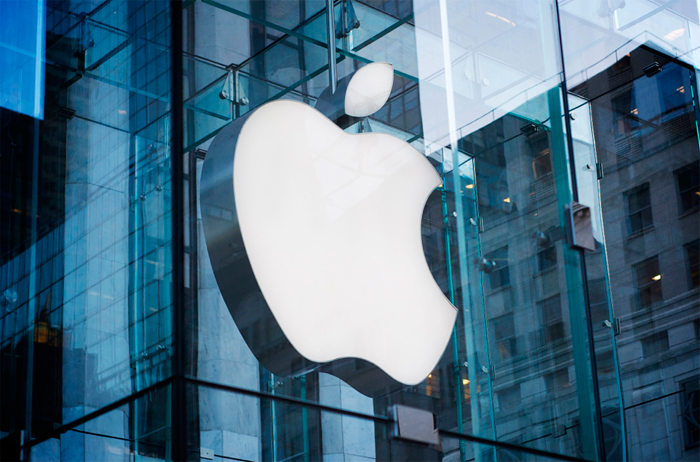
Image via livesicilia.it
In 2016, Apple again takes the Number 1 spot with Forbes estimating the brand’s value at $154.1 billion — definitely a brand worth polishing. If your brand is worth even a fraction of that, you can see why your brand deserves more diligent attention. And even if it’s not there yet, you can appreciate the potential, which makes a brand audit an invaluable tool for brand growth. Any asset with this much value (or potential value) is worth caring for with a regular health check.
And Speaking of Brand Value…
The findings of The Chartered Institute of Marketing’s survey indicate that 75% of marketers consider their brand value and positioning when making any major business decisions. However, respondents also acknowledged weak follow-through and a lower brand experience for customers when management, employees and customers fail to understand and/or appreciate the brand’s role in the business.
Takeaway: A brand audit is not a fluffy light weight marketing exercise. It’s a strategic tool capable of giving you valuable insight into aligning your branding with your business decisions, and needs to be understood by management and employees alike.

Image via The Chartered Institute of Marketing exchange.cim.co.uk
Case Study: MetLife. Navigating Life Together
This video from the Wall Street Journal captures clips from MetLife’s long association with Snoopy. But in its October 20, 2016 press release, MetLife global CMO Esther Lee explained the decision to move away from Snoopy and the Peanuts gang: “We brought in Snoopy over 30 years ago to make our company more friendly and approachable during a time when insurance companies were seen as cold and distant…as we focus on our future, it’s important that we associate our brand directly with the work we do and the partnership we have with our customers.”[4]
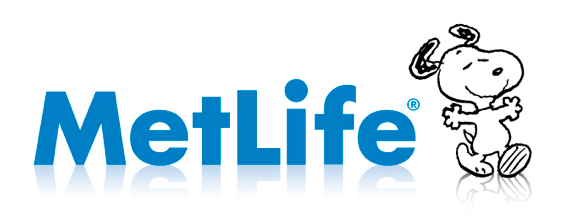
Image via MetLife
Today, MetLife is in the middle of a significant corporate realignment. It’s spinning off its domestic retail life insurance business in the United States to focus more on group life insurance sales and international business operations. Consequently the old logo must give way to a more corporate and international style reflective of its changed positioning:

Image via MetLife
But a rebranding of this magnitude, the decision to drop the cartoon characters, create a new logo, and change the tagline are only part of the process. It’s the result of a thorough analysis and understanding of the brand —in terms of the company, its competition and its customers and prospects.
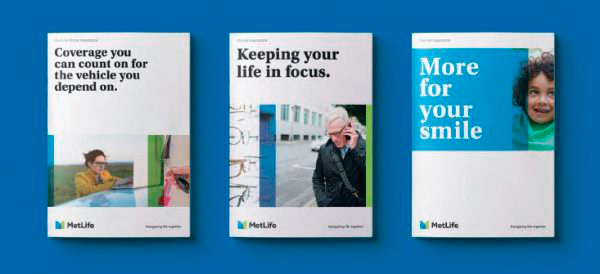
Image via MetLife
You face many important tasks as you begin a rebranding process — potential pitfalls and mistakes as well. To help you prepare, download our free report, “Top 20 Rebranding Mistakes to Avoid.” Sign up with your name and email address, and we’ll send you a copy.
Are You In Need of a Brand Audit?
A total rebrand or brand refresh is only one reason to consider a brand audit as a place to start when determining if your brand is performing. Listed below are key business reasons for conducting a brand health check…and why your brand may not be delivering significant profits:
- Losing market share to your competition in your industry or product segment
- Your business or organizational focus has changed
- Poor performance in online search, no longer landing on page one with Google or insufficient impact in digital media
- Numerous business changes coupled with endeavours along the way to adjust your brand may have undermined your brand identity and created confusion both in your customers’ minds and amongst your internal team and stakeholders alike
- Your sales are declining and your marketing strategy is not delivering the required results
- When questioned about your brand, customers and prospects seem to have little or no brand recognition and low brand recall
Brand Audits Help You Grow Profits
When you conduct a brand audit effectively, driven by clear objectives, you can:
- Pump fresh interest into your brand
- Present a more consistent (and stronger) identity aligned more closely with the goals of the business
- Evaluate your strengths and weaknesses so you can identify what to build on and what to work on, or eliminate and where to improve performance
- Gain a greater understanding of your customers — what they like, what they need and what they want from you and what they don’t like — and how your business and your brand can better meet their needs
- Take advantage of the brand audit process to build greater communication internally across the company (with employees and partners) and externally (with customers, prospects, general public and target markets)
For additional resources and tips, check out our article “Brand Audits: 10 Things Successful Brand Owners and Managers Must Know.”
Start Your Brand Audit with Well-Articulated Objectives
Start your brand audit with a thorough understanding of what you want to accomplish. What are your objectives? Are you trying to determine why your market share is dropping? Do you need greater insight into how to reposition your company going forward? Are you trying to build a recent acquisition or change in direction into your brand image and messaging? Do you need to convert customer or prospect awareness into stronger brand familiarity? Do you need to measure sentiment for your brand in the marketplace?
Even if your brand is performing reasonably well, avoid complacency at all costs — now is the time to give it a health check to prevent any downward turn so you can leverage it more strongly to accelerate your profit growth.
While you’re thinking about these and other questions, take a look at our step-by-step brand audit ecourse. If you want to give your brand a health check yourself, our Auditing Analysis Accelerator™ programme can help you with an under-performing brand, a routine brand health check or a comprehensive analysis to identify your strengths, weaknesses and growth opportunities.
By keeping your focus squarely on your objective(s) you’ll end up with a report, a set of recommendations and a blueprint for going forward that is an actionable document that will help you make the right decisions. You’ll come away with a strategy and a starting point for developing the necessary marketing tactics.
Elements of Your Brand Audit Methodology
There are many ways to audit your brand, and not all audits will require every possible type of analysis. In fact no two brand audits are exactly the same. The depth and scale of a brand audit is dependent on your objectives, resources and timelines. Your questions will help you determine your choice of methodologies and the metrics.
Takeaway: There is no right or wrong brand audit…only the one that gets you the information and answers you need to make the right decisions going forward so you can accelerate your growth.
Here Are 6 Keys Steps and Questions to Get You Started With Your Brand Audit:
Step 1: How does your brand align with your target market?
With your basic questions in hand, you can begin the research phase of your brand audit.[5] You’ll need to collect a lot of background information: Google and Bing searches are a good place to start. You can also hire a professional to conduct an in-depth analysis of your industry. And in addition to visiting your competitors’ websites and social sites, you can collect competitive intelligence through resources such as Hoovers, Dun & Bradstreet, SimilarWeb and Alexa. Some of the topics you’ll want to research:
- Market Intelligence: Market niche, target audience
- Company Information: Mission, vision and Unique Selling Proposition (USP), sales trends, customer support results, logos and brand image documents, brand collateral material
- Industry Insight: Industry trends, competition (who are they and how do they compare in terms of price, support, customer experience, product offerings?)
Step 2: Does your brand deliver on your business objectives? Market intelligence? And industry insight?
With the raw data in hand, you need to assess your brand image, message and actions in the context of your company, your products, your market and the industry. How effective is your brand? Is a weak brand resulting in business being left on the table? Are you losing to stronger, more recognized brands? Do your employees, customers and prospects align with your brand? Can they articulate what your brand stands for and what makes it different to your competitors?
- Discuss the your brand internally with management and employees
- Query customers and prospects with online polls, phone surveys and email questionnaires
Case Study: The IKEA Brand Starts With Its Customers’ Needs
The IKEA Group reminds us that both good business ideas and good branding starts with a thorough understanding of customers and their needs. In “The Story of How We Work,” IKEA has turned the story of how they deliver the right products at the right prices with the right corporate culture into the brand.
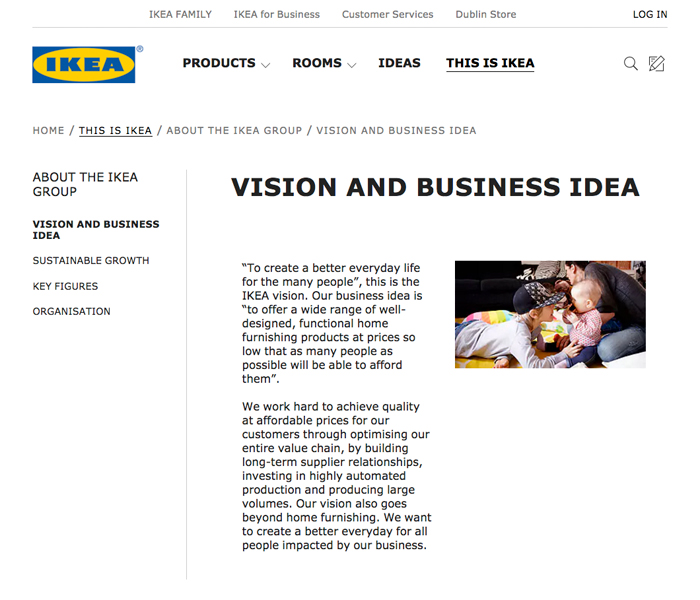 Image via IKEA
Image via IKEA
Takeaway: Using digital illustration to sketch the business process reinforces the how-to and DIY aspects of the IKEA brand. The fact that the story comes full circle—back to the customer—proves that people and their needs are always central to the business and the brand.
Step 3: What’s your SWOT?
Conduct a SWOT-type analysis of your brand to identify and list your brand’s strengths, weaknesses, opportunities and threats.
- What are the best assets associated with your brand — e.g. visual, message, trust? These are strengths you can leverage
- What are your weaknesses and liabilities — e.g. negative press, limited recognition, small audience? Not only do you need to know about any downsides you need to decide if liabilities can be turned around or offset
- Where are your opportunities — e.g. new or untapped audiences, new products well positioned in the market, potential market disruptors? Once identified you can consider the strategy and tactics that will enable you to take maximum advantage of opportunities
- Where are the threats — e.g. new competitors, changing market trends, next-generation technology, challenger brands? Once you know the threats, you can develop ways to mitigate their impact
Case Study: Burberry Leverages its Origins
When Angela Ahrendts joined Burberry in 2006 as its new CEO, she and then Chief Creative Officer Christopher Bailey focused on new and innovative ways to leverage their strength. Burberry asked, “What do we have that they [the competition] don’t?”
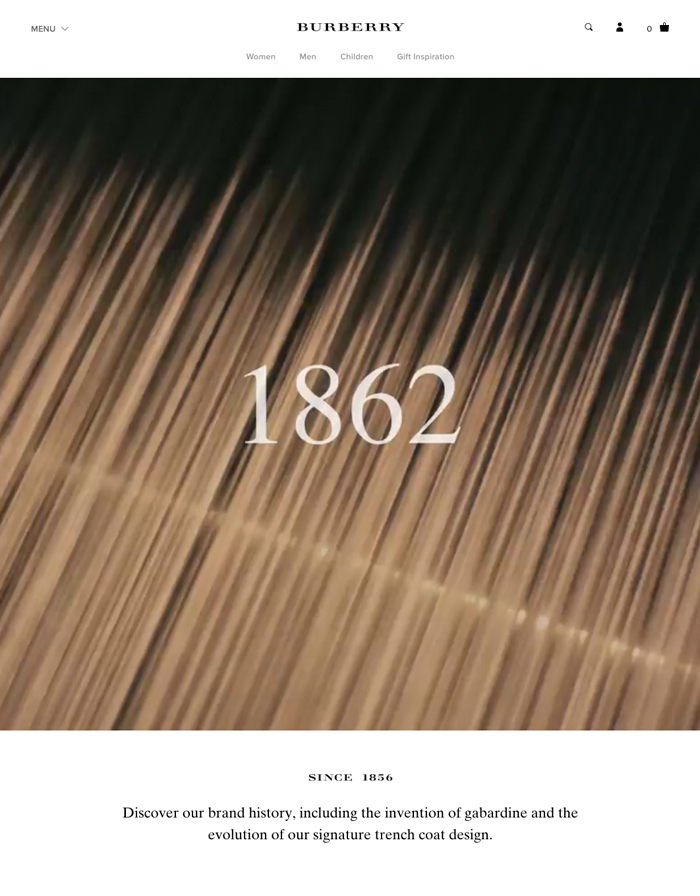 Image via Burberry
Image via Burberry
Takeaway: Burberry went back to its strong roots: British origins and the iconic trench coat. With this insight, the implementation was simply a matter of using creativity in presentation, social media, music and models to build a brand that worked in the 21st century.
Step 4: What’s the brand recognition and recall factor for your visual elements, your messaging and your actions?
Questionnaires, polls and one-on-one conversations will help you understand how effectively your brand is connecting with customers and prospective customers. This is a somewhat subjective process — since you’re relying on people to tell you honestly what they think. It will, however, help you understand the associations and awareness surrounding your brand. Ask customers and prospects about all aspects of your brand, including:
- Logo, colours, taglines
- Brand collateral materials
- Product packaging, trademarked programmes and services
- Customer support programmes
- Consistency of brand across products, websites, marketing materials social sites, etc.
Step 5: Is your social presence aligned with your mission, vision and business objectives?
Given the strong digital presence of most marketing today, you may want to do a social media audit to determine if your brand comes through loud and clear and consistently and congruently on all your social platforms. For example:
- Do you have a consistent brand image and congruent messaging across all your social sites?
- Is your website’s user experience consistent with the brand experience you want for customers and prospects?
- Are you taking full advantage of the features and strengths of each social platform to best position your brand while maintaining consistency?
Step 6: What’s your traffic analysis?
You’ve asked customers and prospects for their opinions about your brand. By measuring online behaviour you can separate what people say from what they actually do and how they respond to your digital brand marketing?
- Are the number of visits to your website, social sites, digital ads increasing?
- How many unique views do you have each month?
- How many are return visits?
- Are your Likes growing along with sales?
- What’s your bounce rate? Are people spending more time on your sites? Are they downloading lead generating brand collateral?
- How many conversions do you have? Are people clicking through, responding to your call to action and/or buying?
An Inspiration and Reminder to Think Different
In 1997, Steve Jobs had just returned to Apple, and one of his first tasks was to rescue the brand. After several years of confusion and poor management, Apple products and the brand itself had declined and the company faced the possibility of failure.
In this video, Steve Jobs explains his plan to revive the business and the brand by focusing not on speeds and feeds (features) but the value of human innovation and positioning Apple as the company that understood, respected and supported those among us who Think Different.
Jobs’ explanation, serves as our reminder to focus our brand audits on our strengths and our customers. We increase our chances of succeeding when our brand audits bring us in touch with our strengths and our customers’ needs and help us put both in the context of our industry, our target markets and business objectives. Writing in Forbes in 2013, Columbia University professor Panos Mourdoukoutas explained brand value: “Those attributes must ‘seduce’ the consumer’s mind, address genuine consumer anxieties and emotions — and be innovative.”[6]
Five Tips for Using Your Next Brand Audit Health Check to Increase Your Profits and Grow Your Business
- Business decisions and brand go hand-in-hand. Tie any significant changes in the business (e.g., acquisitions, future plans, product restructuring) to the brand. A brand audit will help you understand where you stand today and what it will take for the brand to engage customers going forward.
- Focus on context. Your greatest opportunities lie at the point of convergence across company values, customer desire and the state of the market.
- Leverage your strengths. Start from your core values — the attributes that built your business. Then determine how you can carry them forward. Whether it’s a matter of getting back to basics or pumping new life into trusted values, don’t loose what you’ve spent years building. Reassure customers that you are who you’ve always been and will continue to be.
- Reach out to customers. You can’t make business decisions and establish your brand identity in a vacuum. Talk with customers, social and website visitors and, in some cases, random members of the public. Invite them to take part in surveys, phone interviews, focus groups and one-on-one interviews.
- Don’t overlook your digital branding. Today your brand extends to everything you do online — websites, social sites, digital ads, YouTube videos and more. Plus, with new tools and marketing automation technology, you can quantify more of your results. You can see what people are doing and compare results with what they tell you.
[1] http://www.bloomberg.com/news/articles/2016-10-20/metlife-to-phase-out-snoopy-branding-as-ceo-reshapes-insurer
[2] https://www.accenture.com/us-en/insight-digital-disconnect-customer-engagement
[3] http://www.forbes.com/sites/kurtbadenhausen/2016/05/11/the-worlds-most-valuable-brands-2016-behind-the-numbers/#126ce3897383
[4] https://www.metlife.com/about-us/brand/MetLife_Launches_New_Brand-Press_Release.pdf
[5] http://www.inc.com/guides/201105/10-tips-on-how-to-research-your-competition.html
[6] http://www.forbes.com/sites/panosmourdoukoutas/2013/10/05/apples-most-important-branding-lesson-for-marketers/#46c5410e18e2
What Brands Can Learn From Political Campaigns
/0 Comments/in Brand Personality, Brand Profiling & Positioning, Brand Promise, Brand Relevance, Brand Reputation, Brand Story, Brand Strategy, Brand Values, Brand Voice, Branding, Challenger Brands, Disruptor Brands, Personal Branding, Storytelling, Sub-Branding, Sub-Brands /by Lorraine CarterThe races for 10 Downing Street and the White House highlight universal lessons in brand strategy for keen observers. As a brand, there’s none more emotive and powerful than a prime minister or president of the United States.
The time period available in politics for building a party platform, selecting leaders, and creating a campaign is much shorter, and consequently more intense, compared to all other arenas of brand building.
Nonetheless, just like the smallest of brands, the candidates must build that essential emotional bond whether through shaking hands, kissing babies or connecting with consumers at every single touchpoint in a way that’s relevant to them to earn every single vote. As students of brand marketing, the highly focused, condensed time frame and intense process of building a brand to attract voters — similarly to gaining customers — is rich in takeaways for businesses of any size.
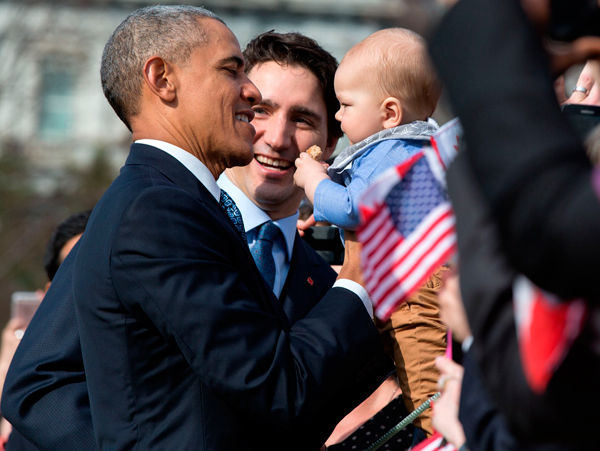
US President Barack Obama and Prime Minister Justin Trudeau – (Public Domain)
Brand Vision: Differentiation is Everything in Brand Strategy
How many times have you heard someone say, “I’m not voting…all politicians are the same.” Political campaigns remind us that clear brand differentiation is key if you are to capture your audience’s attention, imagination and support. In politics that vision is policy; in branding that vision can be whatever you choose…as long as it’s undeniably clear, relevant to your primary audience and expressed in easy to understand language that resonates with them.

Image via hillaryclinton.com
Explain your brand vision. Paint a picture of what the world could look like and how others can be part of that when they buy into the vision of your brand. This must be a really bright North Star that shines for your audience and attracts word-of-mouth referral time after time.
Listen as US President Franklin Delano Roosevelt delineates four essential human freedoms. FDR’s “Four Freedoms” speech leaves no question regarding the nation’s vision, “attainable in our own time and generation,” on the eve of US involvement in World War II.
Listen as John F. Kennedy takes just 30 seconds to articulate his vision in the 1961 inaugural address, speaking first to Americans and then to fellow citizens of the world.
Healthy Brand Competition
In sales training, we’re taught to emphasize benefits; trashing the competition is not the right approach. Some politicians are known to be terrible at this. Instead of articulating an optimistic vision, candidates often tell you how lousy the incumbent and/or the competition is. Arguably some consider Donald Trump to be the champion of insults — a skill he developed on reality television and honed in debates — which doesn’t always translate so well in real life.
To get out the vote, that political position must be communicated across all stakeholders: volunteer voter registration workers, doorbell ringers, call centres, college campus activists, hundreds of regional election headquarters, social media gurus, data experts, staffers, media and the public. To gain customers, that brand message must be reflected at every touchpoint and resonate with current buyers, prospective buyers, suppliers, vendors, distributors, every employee, shareholders, investors, and the CEO.
In the absence of articulating and sharing a compelling brand message, disinterest develops, or even cynicism and mistrust. In politics, this translates into divisiveness, fear, insecurity — and a landslide for the opposition. For a brand, it means that reputation suffers and sales decline.
You Are Your Brand
The brand called YOU is a multi-layered lesson we can learn (both good and bad practices) by watching the political stage during an election cycle. Certainly, public opinion can be influenced by the packaging: takeaways like Hillary Clinton’s pantsuits and Donald Trump’s unique hairstyle make an indelible mark, as with any brand.
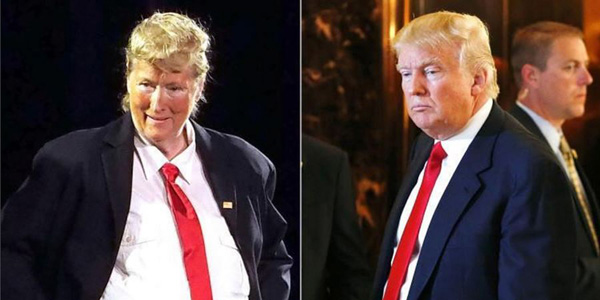
Meryl Streep as Donald Trump – (@simply_the_best_ms on Instagram)
Also, brand marketers can observe how politicians use tone of voice, choice of words, truthfulness, authenticity, facts, listening skills, presentation style, distribution channels, frequency, inspirational metaphors, storytelling, consistency or lack of it, and more to make connections and grow audience. On occasion, they provide examples of what NOT to do.
Everyone involved has a chance to be a brand that is worthy of notice via its most important asset: People. Motivated, enthusiastic, hard working, smiling, clever and talented people make all the difference.
Know Your Brand’s Target Audience
Skills and insight go into knowing and understanding your target audience so you can speak their language, tap into their attitudes and values, and build a simple, strong compelling message that they find irresistible. That magnetism factor is a really important part of successful brand building. It’s one of the critical tools used for mapping out your different customer types in what we call Purchaser Personas.
In fact it’s one of the key elements in our brand building programme called the Personality Profile Performer™. You can’t attract the attention of your ideal audience and sustain their interest if you don’t know them intimately — their needs, wants, loves, hates and aspirations. Every business has a minimum of two and up to twenty different customer Purchaser Personas which provide the critical insights and direction for how your brand can speak to your customers — winning their hearts and minds on their terms — so you can grow your business.
The mechanisms of polling, precincts and predicting are complicated. We leave that to the experts. Nonetheless, you’ll hear news commentary about politicians of all political persuasions “appealing to their base” and/or “broadening the base.”
As in branding, the articulation of mission, values, and promise are essential. Communication with target audiences to understand their likes and dislikes is the first step, however talking to the base over and over doesn’t bring in a single new vote. Brand expansion while maintaining brand loyalty with a core audience is the name of the game in politics as in retailing and other customer verticals.
Brand Messaging Cannot be Overrated
The importance of driving powerful brand impact is what Donald Trump might call “H-U-U-U-G-E” because connecting at a deep emotional level moves people strategically and emotionally. The intensity of the brand message is what makes it stand out; the authenticity of the brand message is what makes it stick.
How you communicate with your audience and what message you bring is what keeps audiences loyal and strengthens bonds. As with any branding strategy, placement, delivery, frequency and tone of voice matter. It’s so easy to turn people off with too much noise and overexposure.
In America, where the election process rolls out over two years and intensifies as election day draws nearer, this skill must be managed and sustained over weeks and months, just like a brand must do in the broader marketplace.

Image via donaldjtrump.com
Brand Storytelling Matters
It is critical to stay true to your brand’s DNA and not get lost, unglued, or disconnected. We’re conditioned that way. When a child asks you to read their favourite bedtime story, they’re anticipating the same story with the same ending.
Politicians are famous for the brand disaster known as a flip-flop on issues, and it can cost an election or tank sales. Whether in the political arena or in branding, there’s simply no room for inconsistent storytelling. It kills believability and trust.
The big why behind the brand story challenges us to build stories that promote something for the greater good. With vision, we can create and communicate a loveable brand, or a sustainable brand, or a socially responsible brand, or a caring, charitable brand…just like building a personality that people will vote for.
Sub-Branding Opportunities and Risks
Sometimes brands create sub-brands to serve expansion goals, as in Coors and Coors Light or American Express and the American Express Gold and Platinum Card. The risk is that sub-brands can detract from core brands, using precious time, energy and resources. Secondly, the sub-brand reputation reflects on its parent brand; the overall customer message can become diluted or compromised.
To minimise or eliminate risks, we recommend taking professional branding advice if you’re considering sub-branding to avoid costly mistakes. Planning your brand structures in the form of new or additional related or unrelated products or services, also known as brand architecture, is a critical part of the strategic planning and brand building process. We’ve seen this play out recently on the political world stage. Brand expansion must be taken seriously to protect core brand values. However, adding Alaska Governor Sarah Palin to John McCain’s 2008 ticket diluted the brand.
When Hillary Clinton undertook a six-month vice presidential vetting process, the selection was received quite differently to when Britain’s new Prime Minister Theresa May selected dropout candidate Boris Johnson as foreign secretary in an overnight surprise. The former London mayor’s brand image is reportedly lacking in the required decorum associated with such an important role according to other world leaders.
“My chances of being PM are about as good as the chances of finding Elvis on Mars, or my being reincarnated as an olive.” – Boris Johnson [1]
The Appeal of Disruptor Brands
What did brand managers learn from Bernie Sanders during the 14-month lead up to the Democratic Convention, when the challenger was the Millennials’ poster boy, a lovable white-haired grandfather, small-town Vermont Senator?
- It takes time and resources — generally a year or so — for any challenger brand to successfully disrupt.
- A clearly and passionately articulated brand vision should be communicated over and over again.
- This candidate’s storytelling remained on message (since his youth), establishing strong authenticity, trust and delivering no surprises.
- Bernie Sanders successfully reached a broad audience through brand activation and personal engagement. While pre-imposed deadlines brought his campaign to an end, the branding strategy was successful.
- Watch what happens when a little bird lands on Bernie Sanders’ podium during a speech. The crowd goes crazy and the candidate turns the moment into an articulation of his vision, “No more wars.”
Consider these questions:
- Is your brand vision well developed and clearly communicated?
- Have you shared your brand vision with all stakeholders?
- Is your brand failing to connect and perhaps in need of a rebrand or brand refresh?
- Do you and your employees passionately personify your brand?
- Is your brand story clearly articulated across multiple customer touchpoints?
- Are you considering sub-branding as a strategy for brand expansion?
- Are you a brand challenger with a clear point of differentiation?
[1] http://www.telegraph.co.uk/news/politics/london-mayor-election/mayor-of-london/10909094/Boris-Johnsons-top-50-quotes.html
How Brexit Presents Big Opportunities for Small Brands
/0 Comments/in Brand Audit, Brand Auditing, Brand Audits, Brand Differentiation, Brand Health Check, Brand Personality, Brand Positioning, Brand Relevance, Brand Strategy, Branding, Brexit Brands, Business /by Lorraine CarterBrand Flops: 5 Lessons Brand Managers Can Learn From Epic Brand Failures
/0 Comments/in Brand Ambassador, Brand Audit, Brand Auditing, Brand Champions, Brand Failures, Brand Relevance, Brand Reputation, Brand Research, Brand Risk Management, Brand Risk Mitigation, Brand Strategy /by Lorraine CarterSuccessful branding is not easy. That’s why Coca-Cola, Sony, Microsoft, Ford, Colgate-Palmolive, McDonald’s and more — a few of the world’s biggest brands — have been responsible for some giant-sized branding flops.
In 1957, the introduction of the Edsel by Ford Motor Company was such a big failure that the name “Edsel” has become synonymous with “huge marketing failure.” In fact, Microsoft founder Bill Gates has singled out this example as one of his favorite case studies in what not to do.[1]
In each of the following cases there are numerous reasons for each of these famous brands falling short. In quite few a thorough brand audit would have flagged up some of the risks before they became text book flops.
Let’s take a look at how Ford Motor Company, Coca-Cola, Apple, and other famous names have taught us that even the best brands can perform some of the biggest belly flops ever, providing us with a look at pitfalls to avoid and lessons to be learned.
Lesson #1: Brands Must Understand Customers Needs, Wants and Behaviours
Edsel
In 1955, in America’s motor city of Detroit, Ford’s gas-guzzling Edsel automobile was on the drawing boards. Meant to be the full-sized answer to fill every American suburban dream, they named the car posthumously after Henry Ford’s son.
However, by the time this full-sized automobile was launched in 1957, consumer preference had shifted toward compact cars — a shift that was cemented by a stock market dive. Positioned as the car of the future, Edsel was overpriced, over-hyped and entirely the wrong car at the wrong time. Production was ceased within two years in the costliest mistake American industry had ever known.
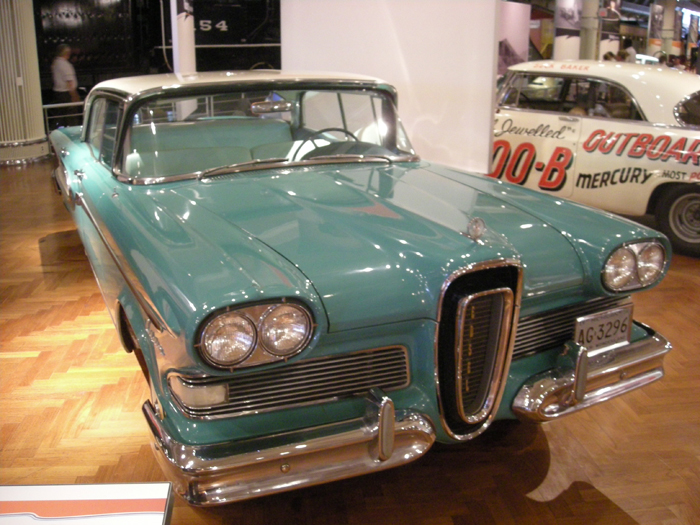
1958 Edsel – Henry Ford Museum, Credit: Michael Barera, Wikimedia Commons 2.5
Coca Cola
In the 1980s, nobody considered the branding of fast-moving consumer goods under the category of apparel, other than as corporate giveaways or inexpensive T-shirts and baseball caps. Yet, Coca-Cola agreed a merchandising deal to create an upmarket fashion line of Coca-Cola Clothing designed by a young, unknown Tommy Hilfiger.
First sold at an Upper West Side New York City store called Fizzazz, the in-store marketing revolved around a soda counter shopping experience, an interactive video screens, and hole-in-the-wall credit card machines called Eric that didn’t appeal to consumers.[2] Instead of print catalogues for its mail order distribution, Coca-Cola Clothing distributed free CDs bearing a message that tried hard to connect the soft drink and the clothing. It read: “Pop this cassette open for a sparkling, carbonated fashion video.”
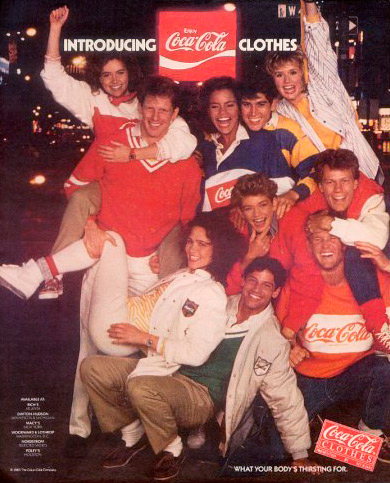
Coca Cola print ad from the 80s (Credit: 237, eBay Store)
The concept was ahead of its time, even for trendy Manhattan audiences; only five of the 650 planned stores ever opened. The Hong Kong-made clothing felt cheap to the touch, featured a poorly designed fit, and the whole thing fizzled out fast.
Apple
Apple, too, once had a momentous flop in 1993. In those days, business cards and a Filofax diary were the tools of networking and time management. Apple tried to change all that by introducing a bulky Apple Newton handheld PC device which debuted at the Computerworld convention.
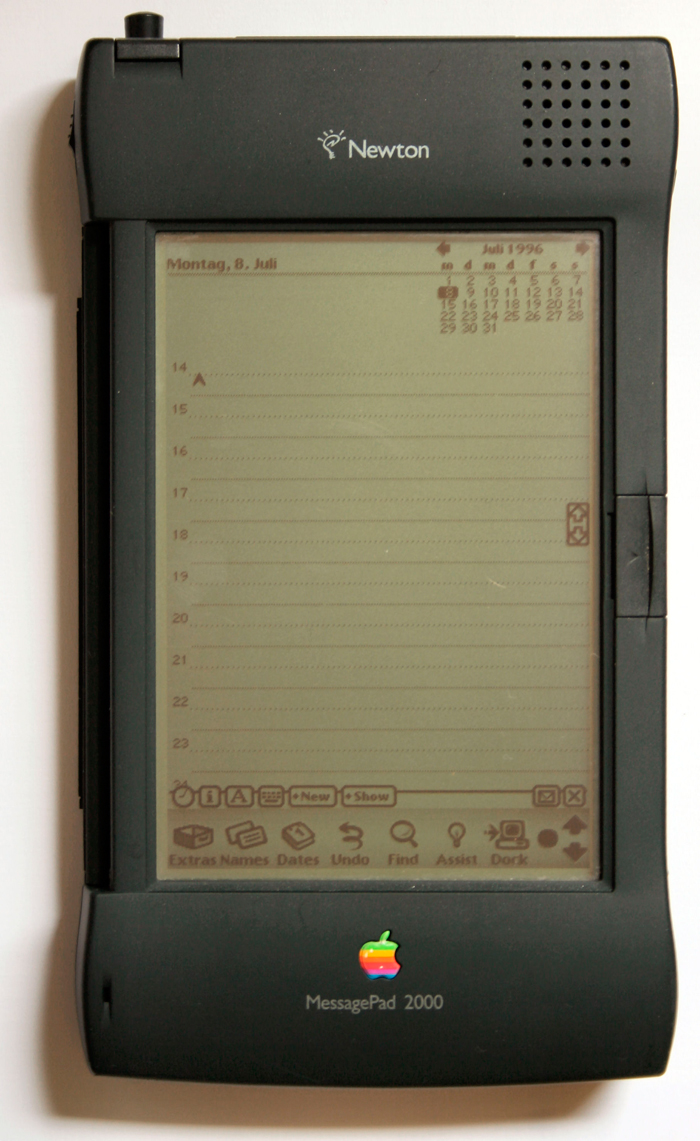
Apple Newton (Credit: Ralf Pfeifer, Wikimedia Commons 3.0)
The world wasn’t ready and the product wasn’t right. Starting at $700, some said it was too expensive, others said too chunky, and everyone agreed it was very poor at reading the handwriting that people made using its stylus. Later versions of personal digital assistants (PDAs) by Apple competitors were enhanced, more broadly accepted by consumers, and sold far better.
Lesson #2: Brand Purpose Must Stay On Point
Brand extensions can be a tricky business. Colgate, Cosmopolitan magazine and Harley Davidson have clearly demonstrated what not to do. It’s difficult to imagine how some of these rather odd multi-million dollar spin-offs made it out of the boardroom, but they did.
Colgate
Colgate is a toothpaste; it promises pearly whites and fresh breath. Yet, in 1982, the toothpaste brand launched Colgate Kitchen Entrées, looking to capture the market in frozen ready-to-eat meals.
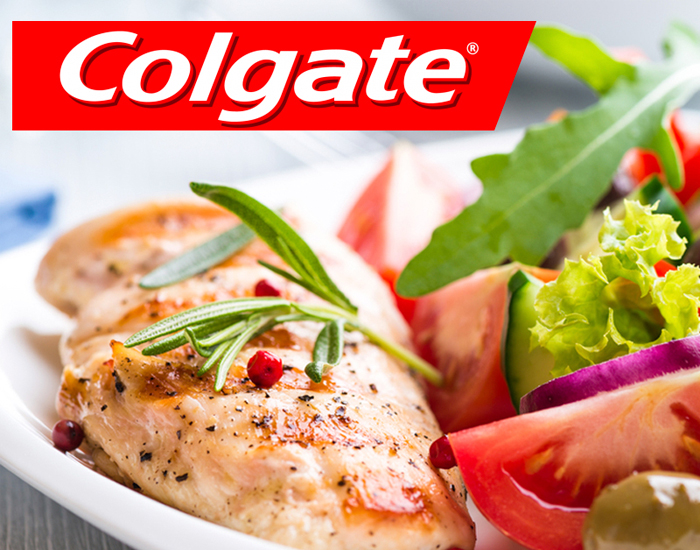
Colgate Kitchen Entrees (via Marketing Directo, Madrid)
Why? Minty toothpaste and frozen peas? This mind-blowing branding concept was as unappealing as its packaging and promptly headed straight for the consumer graveyard, but not before hurting sales of Colgate toothpaste.
Cosmopolitan
In 1999 there was another weird marketing leap by the leading international women’s fashion magazine. Cosmopolitan introduced a line of yogurt on the already crowded refrigerated supermarket shelves.
Cosmopolitan yogurt (Credit: Marketing Week)
Pricing it above the competition and calling it “sophisticated and aspirational,” this misguided off-message product line included Cosmopolitan Light Soft Cheese and Cosmopolitan Fromage Frais. If the brand strategy was, “Cosmo can sell anything,” consumer reaction said that they got that wrong.[3]
Harley Davidson
In 2000, Harley Davidson famously crashed into a wall when it went too far off centre with its drive into branded cologne and aftershave. In hindsight, critics point out that customer audience research and some well developed purchaser personas would have indicated that Harley rider brand values are not focused on smelling divine.
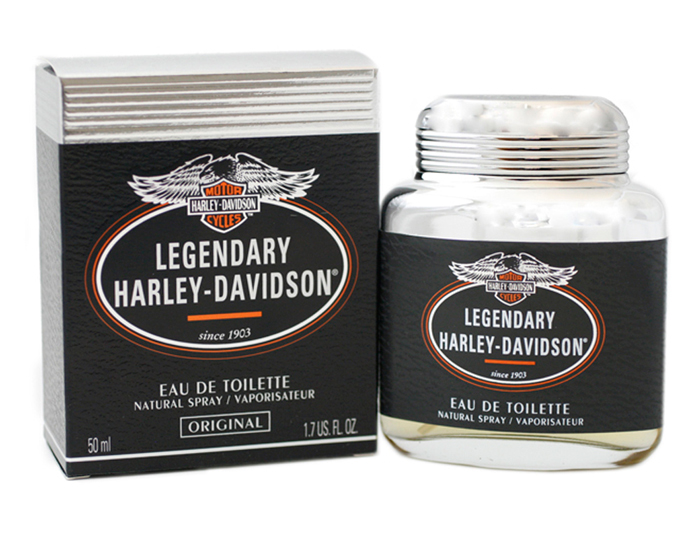
Image via aazperfumes.com.br
Obvious? It’s hardly a surprise that these brand values include: freedom, authenticity, masculinity, toughness…and have absolutely zero to do with wanting to smell charming.[4]
Lesson #3: Brands Must Not Get Lost in Translation
American companies in particular have a long and checkered history of making blunders beyond their ethno-centric shores. General Motors, Pepsi, General Mills and Revlon are among the brands to have messed up on the world branding stage.
Even in the increasingly global marketplace, regional and national differences in traditions, cultural norms and taboos still matter greatly. Well-known translation examples fill the pages of business school case studies.
General Motors introduced the Chevy Nova in Mexico, which translates as “It doesn’t go.” Coors Beer messed up the translation of the tagline, “Keep It Loose” into Spanish as “Suffer from Diarrhea.” In Taiwan, “Come Alive With Pepsi” was interpreted as “Pepsi Brings Back Your Ancestors From the Dead.”[5] Scandinavian vacuum manufacturer Electrolux launched an American ad campaign with, “Nothing sucks like an Electrolux.”
Kellogg’s
Occasionally, deeper cultural gulfs are breached at great expense. In 1994, Kellogg’s invested $65 million introducing its Corn Flakes breakfast cereal to the massive consumer market in India. However, a light breakfast is not the way Indians prefer to start their day.

Cornflakes (Credit: fir0002/Flagstaffotos, Wikimedia Commons)
Furthermore, hot milk on cornflakes (using cold milk was unthinkable to the Indian consumer) turned the product instantly soggy.[6] Pursuing cold drinks, Nestlé fared no better with the idea of iced tea in India.
Revlon
In Brazil, Revlon launched its top-selling Charlie perfume featuring the floral scent of camellias. Since camellias are that nation’s funeral flower, Revlon’s effort was obviously wasted. Money wasted, reputation damaged, the LA Times reported in 1999 that Revlon unsuccessfully sought a buyer for their struggling Latin American businesses.[7]
Lesson #4: Brands Must Evolve With the Times and Stay Relevant
Eastman Kodak
Kodak is a prime example of a legacy brand and market leader which did not keep pace with emerging technology.
In this case, it was the move from film to digital that outdid the brand. Founded in Rochester, NY in 1888, Eastman Kodak Company sent cameras to the moon, encouraged loyal consumers to capture personal “Kodak Moments” for decades, and employed an extended family of 70,000.
Ironically, filmless photography was invented by Steve Sasson, a Kodak engineer, in the mid-1970’s. “It could have been Kodak’s second act,” reported The Street in its article “Kodak: From Blue Chip to Bankrupt.” Instead, Kodak filed for bankruptcy in 2012.
Lesson #5: Choose Your Brand Ambassadors Carefully
Putting your money where someone else’s mouth is can lead to trouble, as demonstrated by brand after brand, including market leaders like Hertz and Nike. Leveraging a CEO, an employee, or a celebrity ambassador as the face of a the brand is a risky business strategy due to the unpleasant surprises that can — and do — crop up.
Hertz
As the very prominent longtime spokesperson for Hertz Car Rental, National Football League hero O.J. Simpson, known as “The Superstar,” had a locktight association with the brand.
The handsome, popular football running back was featured in a TV commercial dashing through airports to get to the Hertz rental counter. A decade as the face of the brand came to a screeching halt in 1994 when he was accused of the murder of his wife and a friend in an internationally publicized criminal trial.
Nike
In 2009, when pro golfing champion Tiger Woods was embroiled in a high-profile sex scandal, Nike suffered for having had him as their brand spokesperson. In a YouTube video aimed at damage control, Nike has Tiger’s father asking him what he was thinking.
The awkward video has had more than 4 million views but raises more questions than it answers. Nike’s bad luck continued with other disgraced sports figures: Lance Armstrong and Oscar Pistorius.
According to an article from London’s Cass Business School, personal circumstances are impossible to predict and extremely difficult to mitigate risk. The lesson learned is “to cut the ties between the brand and the brand ambassador as quickly as possible.”[8]
In all cases perhaps one of the biggest learnings is you should most definitely conduct a brand audit to evaluate your brand’s weak spots and identify new areas for innovation and growth before rushing headlong into a new venture.
Five Questions to Consider:
- Do any other epic flops come to mind, and if so, do you think one of these five reasons accounted for the failure?
- Would you say that having a popular brand ambassador is worth the risk?
- Can you think of other branding examples where a thorough brand audit and proper market research could have avoided a huge mistake at great cost?
- In addition to Kodak, what other brands lost their way by failing to use brand audits, purchaser personas or keep up with rapidly changing consumer preferences in the 21st century?
- Which do you think are the world’s top 10 most valuable brands in 2016…and why?
You may also like:
• Brand Management: Top 10 Tips for Managing Your Brand Reputation
• How Brand Purpose = Purchase = Increased Profitability
• Rebranding Strategy: Why Your Rebrand Must Embrace Storytelling
• Brand Profiling: How to Use Emotion to Make Your Brand More Profitable
• Rebranding Strategy: Using Premium Repositioning To Increase Profitability
• Brand Profiling: Top 6 Components to Creating a Strong Brand Personality
• Brand Audits: 10 Things Successful Brand Owners and Managers Must Know
• Brand Personality: Is Your Brand’s Character Big Enough to Compete?
[1] http://www.wsj.com/articles/bill-gatess-favorite-business-book-1405088228
[2] http://www.nytimes.com/1986/11/09/business/pushing-fashion-in-the-fast-lane.html?pagewanted=all
[3] http://www.huffingtonpost.com/the-daily-meal/6-hilarious-food-and-drin_b_5055465.html
[4] http://www.casestudyinc.com/harley-davidson-brand-extension-failure
[5] http://www.namedevelopment.com/naming-faux-pas.html
[6] https://www.linkedin.com/pulse/attempt-analyze-mistakes-corrections-kelloggs-made-india-utkarsh
[7] http://articles.latimes.com/1999/oct/02/business/fi-17749
[8] http://www.cassknowledge.com/research/article/beware-when-brand-ambassadors-go-astray
Brand Equity: How to Measure the Strength and Effectiveness of Your Brand
/0 Comments/in Brand Audit, Brand Auditing, Brand Audits, Brand Culture, Brand Loyalty, Brand Personality, Brand Profiling & Positioning, Brand Promise, Brand Relevance, Brand Research, Brand Values, Brand Voice, Branding, Business /by Lorraine CarterAccording to statistics, 88 percent of consumers say quality makes them loyal to a brand, and only 50 percent say price is their primary concern. [1] Also, when people have a negative experience with a brand, 50 percent said they were unlikely to consume content from that brand again. Clearly, this data shows how important it is to ensure your brand is sending the right messages to your customers, and making them want to align with it for the right reasons.

Image via www.business2community.com
What is a Brand, and Why is Brand Equity So Important?
Your brand encompasses your total offering to your customers,[2] from what it stands for, to its personality, the experience it gives your customers, what it promises to deliver consistently, the language, tone of voice and messaging it uses to express itself throughout its communications, the fundamental culture of the organization it represents, its brand collateral and the people who represent it.
In short it’s the sum of all its parts from the quality of its offering to its attributes and the emotional meanings associated to it together with all its brand collateral which includes visual identifiers like its logo, website, packaging, printed literature, trade stands, staff uniforms, interior and exteriors site design and signage, vehicle livery, video content and so forth. All of these elements collectively are what make up your brand when they all consistently and congruently engage your primary audience in a way which is relevant to them, yet are distinctive, different and memorable.
Brand equity is then derived from the overall perception of your brand, the way customers perceive your total brand offering, products or services, rather than the just the isolated features and benefits of the offerings themselves. When customers have a favorable brand perception with a consistently good experience, it’s far more likely they’ll remain loyal to your brand, and recommend it to others. In order to achieve strong brand equity, your brand needs to be unforgettable to your customers — it must resonate both with their hearts and their minds.
However, strong brand equity has more advantages than just customer loyalty: [3]
- It enables you to form stronger ongoing relationships and negotiating power with vendors
- Positive brand equity supports long-term company growth e.g. expansion into new markets, product extensions etc.
- Strong brand equity could partially shield you if you hit a bump in the road e.g. reputational ramifications related to something unusual such as defective product or atypical manufacturing delay — assuming you handle the situation appropriately
- Fundamentally customers are willing to pay more for a brand they trust and value
Although brand equity may seem intangible, it has real dollar, euro, or pound value. Brand equity can be tracked and measured using a combination of specialist research and specific algorithms applied on a comparative annual basis.
Measuring brand equity accurately is a niche expertise, with a number of companies specializing in this particular field. Interbrand is one of those companies and they annually track the brand equity value of companies and brands from year to year. By way of example, in 2014 the brand equity of credit card company American Express was $19.5 billion. That figure is impressive in itself, but it’s even more striking to note the brand’s equity value had grown 11 percent from the previous year. [4]
Evaluating Your Brand Equity: Auditing its Current State and Identifying Weaknesses
The first step in analyzing your brand equity is to get a reading of customer perceptions. It’s also important to research employee perceptions for comparative alignment. If there are underlying problems with a company’s brand culture there are also likely to be underperformance issues coupled with incongruent communications that customers will pick up on — all of which means they will be less likely to embrace your brand, and may even doubt its authenticity, which in turn causes a lack of trust.
A brand audit health check is a very useful and practical way to gauge how your primary audience and staff feel about your brand. It can also enable you to identify weaknesses that might not have been noticed previously. Once you identify weaknesses and inconsistencies in your brand, you’ll be in a much better position to convert them into strengths, or at least minimize the aspects of those weaknesses that make your brand less effective when pitched against your competitors. A brand audit health check also enables you to uncover and identify new opportunities for growth and innovation.
Make Your Brand Stronger using Keller’s Brand Equity Principles
When working with our clients to help them develop stronger brand equity, we also advocate principals from Keller’s Brand Equity Model, also known as the Customer-Based Brand Equity (CBBE) Model. It suggests before you’re able to strengthen brand equity, you must first shape how customers think and feel about the brand. [5]
The model is a pyramid shape, with brand identity at the bottom. That section represents the key characteristics and personality of the brand. It’s important customers recognize those attributes correctly, and believe they are different from what competitors offer.
The next level of the pyramid relates to brand meaning. In other words, what does your brand stand for, and how well does it meet customers’ needs, both in terms of performance, and on social and psychological levels? Think about the ways you want customers to experience your brand, and use those factors to create your brand personality and key characteristics.
Brand response represents the third tier of the pyramid. Credibility, actual and perceived quality, and comparisons with competing products all help shape brand response. Your goal is to make your brand evoke direct feelings and innate emotions.
The top level of the pyramid is brand resonance. When customers actively engage with your brand even when not purchasing it, that demonstrates brand resonance, as does a desire to be associated with a “community” of fellow purchasers. Customers also show brand resonance through behavioral loyalty, such as repeat purchases.
Measuring Brand Equity with the Six-Stage Brand Development Model
The six-stage brand development model is a diagnostic tool that combines proven metrics and a framework to guide brand equity strategies. Below, you’ll find the different characteristics a brand should have [6], plus how to make improvements if necessary.
- A Brand Should Be Recognizable: If your brand lacks recognition in the marketplace it’s crucial to develop your brand strategy and enaction it tactically with a fully intergrated branding plan in order to raise its profile. Brand recognition increases through repeated exposure.
- The Brand Must Be Memorable: The brand should be among the first called to mind when customers decide what to purchase. If that’s not happening, educate your target market about what your brand offers and why it’s unique – while remembering to enage your aduience at both emotional and rational levels.
- A Brand Should Be Viewed Favourably: As we often remind our clients, it’s not enough for people to be aware of a brand. The target audience must also believe the brand is able to meet their needs with trust and respect for what the brand represents.
- A Brand Should Be Distinctive: When customers are ready to buy an item (product or service), they must feel compelled to do so because they think the product offers a unique brand promise unlike what any competitors can provide. Brand perception occurs at both functional and emotional levels, so the goal is to position your brand effectively by stressing attributes that motivate purchases.
- The Brand Must Be Preferred: Ideally, customers will prefer your brand over all others, and be willing to purchase it repeatedly. If preference for your brand is low, you’ll need to evaluate why through a brand audit and then implement changes based on the analysis and findings made. Fundamentally you must build brand trust if you want to engender long term brand loyalty.
- Your Market Must Be Satisfied with the Brand: Ideally, customers will be so happy with what your brand offers they aren’t just personally content, but eager to recommend your brand to friends — become brand champions. If that isn’t currently happening, you may need to evaluate where the discontent lies and work on improving your product or service in terms of both percieved and actual quality.

Image via www.mindtools.com
Let’s briefly examine three case studies where improving brand equity was the central goal:

Image via www.starbucks.com
Starbucks
Starbucks has become a global brand worth $10 billion. In 2011, the brand went through a brand identity expansion to boost brand equity. A recognizable green mermaid traditionally decorated bags of the brand’s trademark coffees.
However, Starbucks wanted to expand its future vision by also using its identity more broadly on other products besides coffee, and associate it with offerings like teas and lemonades. The transition to use the mermaid logo more broadly was lauded by industry experts [7], with some believing strongly the broader use of the logo would trigger new growth and bolster recognition, without compromising acquired brand equity.

Image via www.veritaswines.com
Veritas Winery
Established in 2002 as a family-run business, Veritas Wineries was one of the first businesses of its kind in Virginia. The company realized its history and provenance helped establish its brand equity and wanted to implement some brand enhancements without compromising its valuable legacy.
The company commissioned a full brand audit, which resulted in small but meaningful changes [8] to the brand’s identity and made the overall brand more consistent to promote prolonged marketplace success. These alterations have enabled the brand to maintain its dominance, despite increasing competition.
Coca-Cola
Coca-Cola used “Open Happiness,” as a global campaign, to appeal to its consumers’ desire to feel optimistic and be comforted despite a weak economy. At the time, it was the brand’s first new campaign in three years. Advertising spots ran in both print and television media.
Although previous campaigns won awards, some analysts felt they required localized tweaking to resonate with culturally different audiences in different parts of the world. [9] The intention was that “Open Happiness” would have mass worldwide appeal. In the end, that goal was achieved, and the campaign achieved widespread industry praise for its ingenuity.
In conclusion, brand equity is measured one brilliant customer experience at a time. That’s why it’s so important to maintain a positive brand tone, understand how to relate to your target audience in a way that matters most to them, while simultaneously meeting their needs. Building and maintaining brand equity is an ongoing process, remember successful brand building is as much about all the small things you do consistently well coupled with the bigger campaigns and new initiatives.
Key Takeaways:
- Brand equity can make the difference in how customers experience your brand, and whether they want to align themselves with it.
- Brand equity is derived from customer perceptions. Strong brand equity increases the likelihood customers recommend your brand to others.
- A brand audit can indicate how customers perceive your brand, and enable you to identify weaknesses.
- Brand equity is tied to how customers both think and feel.
- Brands should be preferred, distinctive, favorably viewed, recognizable and memorable if strong brand equity is to be achieved.
Questions to consider:
- What actions or brand strategies could be implemented to increase customer engagement with your brand?
- What would help improve the actual and perceived quality of your brand?
- Have you taken steps to become informed and evaluate your brand’s weaknesses compared to competitors?
- Do you feel your brand adequately conveys why and how it meets your customer needs?
- Does your brand connect with people globally, and is that necessary for its brand equity?
You might also like:
• Brand Personality: Is Your Brand’s Character Big Enough to Compete?
• Rebranding Strategy: Why Your Rebrand Must Embrace Storytelling
• Brand Loyalty: 5 Key Steps to Building Your Loyal Fan Base
• Brand Audit: Tips for Determining Your Brand’s Health – Can It Be Improved?
• Humanizing Your Brand: Why It is Key to Commercial Success
• Brand Differentiation: 30 Ways to Differentiate Your Brand
• Brand Profiling: Top 6 Components to Creating a Strong Brand Personality
• Creating New Brands: Top 10 Tips for Brand Success
• Brand Profiling: How to Use Emotion to Make Your Brand More Profitable
[1] Eric Hammis, http://www.business2community.com, “How Important is Brand Identity?”, April 2015.
[2] Lois Geller, http://www.forbes.com, “Why a Brand Matters”, May 2012
[3] John Fatteross, http://www.thehartford.com, ” Advantages of Strong Brand Equity”
[4] Jennifer Connelly, htttp://www.entrepreneur.com, “‘Brand Equity’ is an Intangible That’s Worth Real Money”
[5] https://www.mindtools.com/, “Keller’s Brand Equity Model: Building a Powerful Brand”
[6] http://rockresearch.com/a-brand-development-model-how-to-define-and-measure-brand-equity/, “A Brand Development Model: How to Define and Measure Brand Equality,” December 2013
[7] Carl Johnson, http://www.adage.com, “Why Starbucks Logo Change Doesn’t Equate to Brand Change,” January 2011
[8] http://www.designbywatermark, “What is a Brand Refresh?”
[9] Betsy McKay and Suzanne Vranica, http://www.wsj.com, “Coca-Cola to Uncap ‘Open Happiness’ Campaign” January 2009
Eleven Branding Lessons: Keeping a Sharp Eye on Your No.1 Asset
/0 Comments/in Brand Audit, Brand Auditing, Brand Audits, Brand Collateral, Brand Health Check, Brand Name Creation, Brand Name Origination, Brand Personality, Brand Relaunch, Brand Relevance, Brand Reputation, Brand Research, Brand Risk Management, Brand Risk Mitigation, Brand Strategy, Branding, Customer Engagement, Rebranding Mistakes, Situation Analysis /by Lorraine CarterOnce the heavy lifting in creating your brand is done, basic care and ongoing maintenance to preserve and protect it must not be overlooked. “Nurture your brand as you would a child,” says brand expert Jagdeep Kapoor, author of the bestselling “Twenty-Four Brand Mantras.” Just like all living things, a brand requires nurturing to remain healthy and to grow.
From creation through to end-of-life, a brand can encounter unexpected challenges arising from all sorts of corners, not just from the competition. From a poorly planned campaign to a corporate takeover, and from an outspoken CEO to a badly chosen name, a few examples that made recent headline news are worth a closer look to form takeaways and lessons learned for brand owners and managers everywhere.
Case Study: Rhode Island Is Not Iceland – Tourism Campaign Has Too Many Mistakes, Says Governor
America’s smallest state ought to know that details matter. When Rhode Island set out to create its new $5 million integrated tourism and new business promotion campaign, big guns were brought in. Who better, you might think, than Milton Glaser, the graphic designer who created the iconic I ❤ NY campaign?
Lesson #1: Politics matter! Milton Glaser and Havas PR North America, chosen for the PR contract, are New York City firms, not Rhode Island firms.

The newly launched campaign featuring a slogan “Cooler & Warmer” left many people cold…and guessing. What does it mean, they queried across social media channels. One Commerce Corporation board member said he saw “no emotional connection” and “no personal brand to the state or the people.”[1]

An ATOM Media executive in Providence, RI said, “Usually a slogan is something that people know instantly and understand. I think the fact that you need to explain it could be a little problematic.”[2] That sentiment was echoed by the owner of a Newport, RI marketing and graphic design agency, who said the slogan, “Doesn’t make any sense to me. In order to create a good tagline you have to have a brand strategy.”[3]
Lesson #2: Brand strategy comes before name, tagline and logo creation.
Lesson #3: Graphics must reflect and express a brand’s persona, and that must be one that resonates with people, not one that needs to be explained.
Lesson #4: Social media matters! A tagline containing a special character or symbol (such as the ampersand in Cooler & Warmer) won’t function as a hashtag[4]. Ever.
That wasn’t all. A YouTube video released with great fanfare was yanked within 24 hours when it was pointed out, “Hey, that’s not Rhode Island — that’s the Harpa concert hall and conference center in Reykjavik. Iceland.”[5] Other footage featured a highly acclaimed restaurateur who had already moved his operation to Boston. And the video also claimed 20 percent of America’s historic sites are in the little Ocean State, when it’s actually 2 percent.[6]
This was the ‘alternative’ Rhode Island Cooler & Warmer ‘spoof’ version produced by The Wonderful Show!
Lesson #5: Accuracy matters! The state’s marketing director resigned. Media partners are returning their contract fees to the taxpayers. Cooler & Warmer was scrapped.
After an initial attempt — picked up internationally, even by The China Post[7] — Governor Raimondo took a different tack at a news conference, saying, “One of the things I’ve learned from listening and engaging with people is that there should’ve been more public participation in this thing from the get-go.”[8]
With that in mind, Newport Buzz posted a public contest, pitting “Cooler & Warmer” against the previous slogan, “Discover Beautiful Rhode Island,” and a local amateur entry, “Sea to Believe.” With 15,000 votes in so far, the local resident’s idea is clear away the favorite with 80 percent, versus the traditional one at 18 percent and the costly new-fangled entry coming in dead last at 2 percent.
Lesson #6: There’s no room for ivory tower decision-making. Consultation is critical, brand audits are essential.
More Takeaways: All brands should consider geographical location of their contractors and supply chains when performing due diligence in order to avoid potential embarrassment. The look and feel of the brand via tagline, logo, adverts, all brand collateral, media and all touchpoints must resonate with its audience, make an emotional connection and be authentic. The importance of fact-checking and the need to eliminate exaggerated claims cannot be overstated. Handle a brand crisis with carefully thought-out strategy, not something to poke fun at.
Case Study: Brand Takeover – Richard Branson Reacts to Virgin America Sale
Sir Richard Branson is himself a brand who runs a brand that has sub-brands. The self-made billionaire wasted no time addressing the Alaska Airlines purchase of Virgin America — just in case of any tarnish rubbing off on the overall Virgin brand name.

Image via www.virgin.com and Virgin America
Well aware of the fierce loyalty of Virgin America fans for what they consider a superior product at parity prices, Branson let everybody know, “I would be lying if I didn’t admit sadness that our wonderful airline is merging with another. Because I’m not American, the US Department of Transportation stipulated I take some of my shares in Virgin America as non-voting shares, reducing my influence over any takeover. So there was sadly nothing I could do to stop it.”[9]
Lesson #7: Confront a brand crisis. Deal with it, manage it, communicate about it professionally and do not hide from it.
In a statement that’s a pleasure to read in its entirety, due to the passion readers can sense, Branson goes on to discuss the importance of the brand, “…once Alaska witnesses first-hand the power of the brand and the love of Virgin America customers for our product and guest experience, they too will be converts and the US traveling public will continue to benefit…”
Even in the face of a forced merger, the rest of the Virgin brand received immediate reinforcement from the top. “Our Virgin airline has much more to do, more places to go, and more friends to make along the way,” Branson stated.
Lesson #8: Find the silver lining. Notice how Branson uses this corporate takeover event as an opportunity to reiterate the ongoing benefits of a Virgin travel experience.
Case Study: Tarnished Brand – Trump Empire?
In his run on the US presidency, Donald Trump’s raucous attention-grabbing style and statements is affecting custom at Trump Collection branded apartment towers, hotels, resorts and golf courses.

Image via http://www.npr.org
Polling and consulting firm Penn Schoen Berland survey results found that 45 percent of respondent US residents with annual earnings of $200,000 or more will make a point of not visiting a Trump hotel or golf course over the next four years. Within that group, 77 percent indicated they would actually boycott the Trump brand.[10]
Lesson #9: From the CEO to front line employees to the back of the house operation, your brand is represented by everyone in each and every customer (and potential customer) interaction. Everyone is, or should be, an ambassador for your brand.
Case Study: Stay Relevant, For The Times They Are A-Changin’
In the 1980’s, four-time Olympic diving gold medalist and five-time world champion Greg Louganis was passed over for one additional honor — an appearance on the Breakfast of Champions Wheaties Legends cereal boxes. Louganis is openly gay, HIV-positive and an LGBT activist. He is also “widely viewed as the greatest diver in the history of the sport,”[11] according to a recent communication from the Wheaties maker, General Mills.
Calling it “a ground swell of love,” Louganis told Hollywood Today that a petition signed by 40,000-plus people brought the oversight to the attention of General Mills. At age 56, Louganis joins a highly decorated Olympian swimmer and hurdler, a woman and a black man, in the brand’s revamped Wheaties Legends series packaging, available on the grocery store shelves (one million boxes!) from May 2016.

Image via http://www.blog.generalmills.com
Lesson #10: A brand needs to stay relevant to stay alive. The brand must respond to feedback and act to correct an out-and-out mistake.
Case Study: What’s In a Name – Law School Learns to Study Harder
Experts highly recommend that even the smallest of brands invest time and effort in getting a name right from the start to avoid potential legal issues and massive upheaval if a change is required. That advice takes into consideration everything from spelling to acronyms to trademark and domain name. Later, a brand might tweak a logo, revamp packaging design, shift media channels, or even undertake a rebrand if necessary.
AdWeek reports that a recent study by U.K. research firm MillwardBrown found “many brands that change their names can expect an immediate 5 to 20 percent drop in sales, and that the new brand image ‘may not be as strong as it was before.’”[12]
After U.S. Supreme Court Justice Antonin Scalia passed away in February, George Mason University outside Washington D.C. renamed their law school after Scalia upon receiving a $30 million gift to do so.

Several tweets later[13], the school realized the awkward acronym they’d created and made a swift change away from Antonin Scalia School of Law, or ASSOL.[14] A crisis was averted at Antonin Scalia Law School before any signs went up or ribbons were cut.
-600px.jpg)
Image via https://www2.gmu.edu
Spelling Counts: When Small Brands Make Big Mistakes
Branding experts point out that misspellings, bad foreign language translations and tricky signage is an area frequently causing trouble at small companies which attempt an in-house branding effort. Even big brands don’t always get it right, with sometimes alarming results.[15]
Amusing examples can occur when random neon lights fail and the Essex House becomes Sex House and Dynasty Restaurant becomes Nasty Restaurant.

Image via Reddit
Even an airport parking garage can be considered part of the airport’s brand. Here’s a curious example of why details matter, right down to vetting your contractors and proofing the signage.

Image via Reddit
Lesson #11: Seek professional assistance in naming a brand to avoid potentially disastrous errors and oversights.
Questions to consider:
• Would you agree that branding is even more important and valuable for small businesses than it is for big companies?
• Have you fully addressed your brand profiling, positioning and brand strategy prior to jumping into logo design or tagline development?
• Have you considered consumer research and due diligence of supply chain as part of your brand audit prior to brand launch or re-branding?
• Have you fully considered and defined differentiation within your brand? How is your brand really different distinctive and memorable?
• Have you determined that your brand rings true and authentic for its target audiences? Have you developed you purchaser personas for each of your different customer types?
• Have you seen other examples of common mistakes amongst other brands that you can learn from?
[1] http://pbn.com/Commerce-RI-board-member-Throw-Cooler-and-Warmer-slogan-out,113203
[2] http://turnto10.com/news/local/ri-commerce-corp-releases-state-promotional-video
[3] http://pbn.com/Commerce-RI-board-member-Throw-Cooler-and-Warmer-slogan-out,113203
[4] http://mashable.com/2013/10/08/what-is-hashtag/#tQ14Pph.xuqT
[5] http://www.theguardian.com/us-news/2016/mar/30/rhode-island-tourism-video-mistakenly-features-reykjavik
[6] http://www.abcfoxmontana.com/story/31604583/rhode-island-governor-says-iceland-video-may-draw-tourists
[7] http://www.chinapost.com.tw/life/offbeat/2016/04/01/462288/Rhode-Island.htm
[8] http://wpri.com/2016/04/01/ri-chief-marketing-officer-resigns-after-cooler-warmer-debacle
[9] https://www.virgin.com/richard-branson/virgin-america
[10] http://www.npr.org/2016/04/05/473146450/how-will-trump-the-brand-survive-trump-the-candidate
[11] http://www.blog.generalmills.com/2016/04/evans-louganis-and-moses-get-wheaties-honor
[12] http://www.adweek.com/news-gallery/advertising-branding/11-brand-names-simply-couldnt-survive-times-163440
[13] http://fortune.com/2016/04/06/antonin-scalia-school-of-law
[14] http://www.cbsnews.com/news/antonin-scalia-school-of-law-renamed-due-to-awkward-acronym
[15] http://blog.hubspot.com/marketing/spelling-grammar-mistakes
Branding: Creativity without Strategic Rigour is a Waste of Budget
/0 Comments/in Brand Personality, Brand Profiling & Positioning, Brand Promise, Brand Relevance, Brand Story, Brand Strategy, Brand Values, Branding, Disruptor Brands, Entrepreneur, Storytelling /by Lorraine Carter“Creativity is Intelligence Having Fun.” – Albert Einstein
2016 will be a year of convergence for brand strategies. As Joel Comm[1] put it, “there’s nothing more social than face-to-face engagement,” and this is the application strategy that brands need to focus on. They need to combine traditional marketing with the emerging. They need to be creative, smart, strategic, and more than anything disruptive. Look at what Amazon is doing. They changed the way the world shopped by pulling in customers online. Just when everyone got hooked, they are focusing on brick and mortar stores. Disruption, new methods and new forms of engagement is the life blood of successful brand strategies.
Why is that important? Because you have to constantly innovate and look at how you use branding more strategically and more creatively. It’s not just a logo or a design and its not just strategy and analytics either.
Instead of just a scientific or design endeavour it should be looked upon as a process that combines analytic and creative thinking. As Sun Tzu[2] had described in The Art of War, “Strategy is an Art; never a Science; it is the Art of the conscious mind in action.”
Brands need creative and artful strategy to be actionable. No strategy, traditional or digital can operate on its own in isolated silo. It needs to be creatively aligned and converged in a cohesive brand message, to offer a complete brand experience.

Image via www.storify.com
Strategy and creativity go hand in hand and this is exactly what Airbnb’s CMO Jonathan Mildenhall[3] emphasized at the panel discussion hosted by The Economist at 2015 Cannes Lions. As he and others in the panel pointed out, there is data and then there is the need to manage this data and extract the brand story hidden within.

Image via www.storify.com
Mildenhall points out that strategic thinking does not have to kill creativity, though if abused it can smother all ingenuity. Equally, creativity without solid strategic thinking frequently fails to deliver the required commercial returns as well. Both are needed and must go hand-in-hand for optimum success. Businesses need to use the data creatively, not use it to stifle creativity and creativity needs to be underpinned by informed brand strategy.
One of the most common mistakes amongst SMEs is that they don’t employ strategic rigour, unlike larger or global brands, which sometimes squash creativity in favour of too much data analysis. It is imperative that creative talent and strategic thinking be merged seamlessly because one is incomplete without the other. In other words, strategic rigour is the essential foundation on which to build creativity.
Therefore, design should never be based on just subjective aesthetic preferences but driven by a well-developed brand strategy. This includes research and analytics together with developing the whole platform of the brand through brand profiling (vision, mission, values, purpose, promise, personality, archetype, story, tone-of-voice, purchaser personas, positioning) and so forth.
As Mildenhall said, when you can state the “non-obvious truth” as a great strategic insight, your brand has won. For you are now hitting on something that is there but has not been noticed or considered before. It takes creativity to get to this point but also means a walk among the data.
Branding sets the stage for clients’ expectations and creativity needs to be activated to bring that promise to life and deliver on it in a ways that’s relevant to the brand’s primary audience.
A salient fact to reflect on –
Your audience couldn’t care less if 73% of the world’s brands disappeared tomorrow – Havas Media
Yes, this is alarming but it’s true so now is your opportunity to ensure you’re not the brand that’s easily forgotten. Instead, develop a strategic foundation on which to build your brand now and into the future to ensure it’s different, distinctive and memorable with a purpose and personality your primary audience finds irresistible. Use data and digital strategy combined with brand profiling to inform and provide direction for your brand’s priorities. Use creativity to tell your story informed by data, and use this story to evolve your brand into something people want to talk about, share and refer.
As David C. Edelman[4] pointed out, “… today, consumers are promiscuous in their brand relationships…” The presence of increasing media options and social networks enable them to simultaneously connect with myriad brands and sift through them at will.
Businesses therefore, need to understand which media to use and how to leverage those channels appropriately to share their brand story. All the pieces need to come together in a highly informed and smart brand strategy which is interactive, dynamic and makes for a cohesive customer journey. It’s crucial to create a knowledgebase. It’s important to use the channels like Facebook and Google, if they’re appropriate to your product, service and primary audience, coupled with other marketing automation players.
Before you develop your brand strategy here are some brand facts to keep in mind:[5]
- 45% of a brand’s image can be attributed to what it says and how it says it
Your brand is your promise
- 54% of people don’t trust brands
Much of this distrust comes from broken promises and brand not delivering on customer expectations
- There are 2.1 million negative social mentions about brands in the U.S. alone, every single day
Monitoring, managing and controlling your brand message and reputation is essential
- 48% of Americans expect brands to know them and help them discover new products or services that fit their needs
Customers expect your brand to provide them personalized solutions
- 72% of marketers think branded content is more effective than advertising in a magazine; 69% say it is superior to direct mail and PR
Branded content is an effective way to educate potential clients while establishing your authority in your industry. Build trust with branded content
- 80% of customers said “authenticity of content” is the most influential factor in their decision to become a follower of a brand
Focus on creating authentic content that gives value and reflects the values of your brand without the hard sales push, think pull more than push in your communications
- 60% of US millennials expect consistent experiences when dealing with brands online, in-store, or by phone
A consistent brand is essential. Humans by nature crave consistency. Carefully monitor all aspects of your brand touch points and communications to ensure your audience has a consistent experience
- Colour increases brand recognition by up to 80%
As a professional branding expert and international speaker this colour statistic is one that never fails to surprise audiences or branding master-class participants whenever I mention it. It also underpins why colour psychology is so important, should never be underrated or deployed because of personal preferences.
Colour needs to be leveraged both strategically and creatively, and every brand needs a properly developed colour palette which expresses the brand’s personality appropriately, suits context and cultural preferences while also meeting the needs of its primary audience.
It might be worth reflecting on these statistics in the context of how does your business and brand measure up when compared against them? Would a brand audit health check be in order?
Creativity and data analysis are no longer diametrically opposed tools, operating in disconnected silos. Data and creative teams need to work within a cohesive framework because if one doesn’t inform the other, the entire brand building strategy not only remains incomplete but runs the risk of failing.
Case Study #1 – Connecting Strategy with Brand Performance – Lexus[6]
The latest Lexus campaign is an eye-opener. In order to sell a new 467-horsepower, high-performance vehicle it has eschewed conventional rhetoric and has instead created a branded game.
Called “GS F the Bracket”, this has been developed from the ground up in collaboration with Yahoo Sports. The rollout of the new luxury sports sedan will complement Lexus’ sponsorship of Yahoo’s fantasy sports bracket and the NCAA men’s college basketball tournament. Once registered, users get to pick the player match-ups who they predict will most quickly reach a combined 60 points for a chance to win a “GS F-inspired vacation.”

Image via © www.gsfthebracket.com
The campaign blends in Lexus’ branding strategies with its performance by targeting two very different audiences. The first is the affluent group who can afford to spend $80,000 on a new vehicle. The second is the group of younger prospects who are aspiring to buy their dream Lexus car one day.
Working in tandem with Oracle Marketing Cloud’s data management platform, the automobile giant has invested in an addressable data strategy to optimize its performance based on where the customer is in the Lexus life cycle. So while television is still an important medium for them, they are applying email and transactional data to manage and affect customer mindsets. This is exactly what Airbnb CMO talked about when he stressed on the important of creativity and strategy.
Lesson Learned:
A large marketing budget and a great strategy team will be of no use if the brand campaign lacks innovation. A creative thought process that has correctly analyzed how to engage the customer and generate organic demand will have stronger results leading to optimal sales.
So how should a business engage brand profiling and brand strategy coupled with creative inputs effectively? At the very least you need to have absolute clarity over what your brand stands for, its purpose, what makes it different to your competitors, its personality and the needs it fulfills for your ideal audience together with fully developed purchaser personas for each of your different customer types.
Your brand is not just who you are but also what others perceive you to be. As Jeff Bezos so succinctly put it, “Your brand is what people say about you when you’re not in the room”.
As experts[7] have pointed out in the HBR – Bringing Science to the Art of Strategy, managers who do not reconcile creative with realistic strategies are doomed to weigh the futile rigour of ordinary strategic planning. “The key is to recognize that conventional strategic planning is not entirely scientific…… also integral to the scientific method are the creation of novel hypotheses and the careful generation of custom-tailored tests of those hypotheses—two elements that conventional strategic planning typically lacks.” What this essentially means is that modern strategic planning can only be successful when scientific is combined with artistic.
Creativity and strategy when combined to tap into human emotions, lies at the root of successful branding. There is a growing debate on whether advertising and marketing automation stifles this creativity. When smart brand strategies are applied, marketing automation can actually provide brands with immense opportunity to be proactive instead of reactive. They offer message immediacy and pave the way for data to further fuel branding campaigns. Strategic rigour and application of data allows you to see what’s working and what’s not. This feedback can then be used to feed back into the creative process.
The tools of communications have to be chosen wisely, not just for wider brand creation but to engage human emotions creatively. What you communicate visually and verbally, and the various distribution channels chosen, underpin the foundations of strategically driven branding. All these are the what, where, when and to whom you plan on communicating to.
Case Study #2 – Global vs Local – Airbnb[8]
It is important to create a core global brand strategy. But it is even more important to allow localised ideas more room to scale within the company, in order to be sensitive to different cultural nuances. This is often more difficult for bigger companies because institutional friction and the politics of business often prevents the culturally nuanced to work or build diversity into teams. However, it’s a huge opportunity for the more agile and flexible smaller business.
Social media and the rise of crowd culture have broken through geographical barriers and brings together all communities that were once geographically isolated, thereby greatly increasing collaboration. Airbnb’s innovative use of social media, both in terms of promotion and content, has been phenomenal is driving viral leads.

Image via © http://blog.tortugabackpacks.com
They have fused global experience with direct and substantial local sub-cultural influences. You can find ways to travel free or with minimum outlay and plan your vacation, stories and blogs about the places you are searching, see why Hollywood stars like Gwyneth Paltrow and Beyoncé[9] use Airbnb and post it on their social media page, and find easy ways to connect with the service whenever you are ready to book your flight and hotel.
Lesson Learned:
Progressive means blending cultural innovation with early adopter markets. This is an example of how businesses can combine creative with strategic rigour and reach out to millions of global customers simultaneously.
How can smaller businesses achieve an edge?
Be creative when you strategize your brand message – right at the onset of your brand profiling process. Your brand vision and goals should be fully aligned with your business objectives. It should express your brand personality and be positioned in a way that enables you to stand out effectively while also appearing irresistible to your potential customers. Brand profiling and positioning are the tools and systems that enable you to differentiate your offering from your competitors and rise above the generic confusion and noise.
Consider what you deliver and how you can fulfill that promise in a way that reinforces your differences and distinctions while also making your brand more attractive, referable and memorable to your ideal customer. Build your brand promise around that delivery. It tells your customers what they can expect from your products or services and why your brand matters more to them.
How can smaller businesses balance the need for brand strategy underpinned by creativity?
According to Paris-based branding consultant Bolanile Maté[10], applying smart strategies for example, like heritage and provenance positioning can work extremely well. Though she used Hermès as an example, she also pointed out how these more traditional concepts can capture the imagination of more modern audience too. Its all in the positioning and how you share you’re authentic brand story.
Conventional branding tools have stressed on building brand awareness through repetitive push marketing strategies. Whether it is a print advert or an electronic one, the focus has been on taking the product and placing it in front of the customer, telling them what’s out there, where to find it, what to do and how to use it.
While this has its place in the marketing process, the way this message is delivered has changed. Brand strategy needs to utilize a fully integrated process combining both social and media channels, where relevant, to raise awareness and generate demand. In the age of internet marketing it’s more effective to attract this organic interest with inbound marketing rather than the more traditional push marketing model, to encourage customers to seek out the product, service or company on their own terms. And this is very doable for all smaller businesses and brand owners.
Traditionally, big companies introducing new products into the market use the traditional push marketing strategies when their products are new and unfamiliar.[11] However the smarter ones are utilizing more creative routes combined with well-developed brand strategies. They’re utilizing multiple touch-points and media channels to generate more viral and word-of-mouth brand messaging, all of which smaller businesses can do very flexibly too, on modest resources.
Case Study #3 – Using Familial Roots as a Strategic Tool – cHarissa [12]
This company is a great example of how they blended conventional and new media to make themselves more familiar with their target audience. More importantly, how they strategically used their familial spices to create taste and flavours in a brand that people love.
Octogenarians Earl Fultz and his wife, Gloria Elmaleh of New York started their Moroccan sauces and spices business, “cHarissa” when most people are happily retired. For them the strategy for success was provenance and familiarity – hers with the spices of her familial roots and in his case the food industry.

Image via © http://www.charissaspice.com
They used their prior knowledge as a resource but did not stop there. They went on to hire smart people, the ones who knew how modern marketing worked to build a brand that skillfully expresses its personality and touches its audiences with strong emotional resonance, combined with experience and endurance. They’ve used traditional advertising but the real strength of their brand lies in the word-of-mouth and social marketing coupled with innovative promotions. For example, Earl’s presence as a guest chef led to cHarissa being served at the Revolving Restaurant on top of the World Trade Centre.
That is the power of creativity underpinned by strategy.
Lesson Learned:
It’s very accessible for SMEs and new businesses to integrate conventional and newer media to share their brand message, generate demand for their products and services and grow their brand as a viral phenomenon.
Case Study #4 – Using Creative Social Interactions to Build a Sustainable Brand – Herschel [13]
Vancouver based travel goods and accessories business Herschel Supply Co. used social media not only to improve customer service but also to build memorable impressions through well-thought out and consistent branding strategies. They’ve been very smart about analytics and using this information to leverage hot trends and create proactive customer support.
Using smart business tools like Hootsuite they’ve been able to achieve a 20% lift in customer service satisfaction rate, to serve their customers more effectively and on a more personal level. They’ve also gained about 60% increase in their overall positive brand sentiment.
The result – they have become quite synonymous with modern travel fashion – and their followers comprise of the fashion inspired, tech savvy globetrotters.
Lesson Learned:
The most effective way for SME businesses to get a strong footing in the competitive global market is not to worry about big budget media spending. Instead implement clever social strategies which combine traditional and social platforms to creatively engage your audience with campaigns using creativity underpinned by strategy and strong analytics.
Key Learnings:
- In order to be intriguing and successful every brand needs a creative strategy
- Creativity without strategic rigour is a waste of time and resources
- Creative strategy determines pivotal marketing and advertising efforts
- Analytics needs to merge with creative risks for unique breakthroughs
- A creative branding strategy will help a brand standout and engage its primary audience
- Creativity when based on strong analytical foundations yield robust results
- A strong brand profile has to have an authentic brand story worth telling
Questions to consider:
• Are you employing strategic rigour with your creative endeavours?
• Have you fully defined your brand, what it stands for and what makes it different to your competitors so you can use this brand strategy to underpin your creative outputs?
Are you focusing too much on data analysis and consequently stifling your creative or worse still failing to develop your brand strategy with brand profiling and indulging your creative fantasies without any strategic basis?
• Is your brand strategy based on esoteric data or eclectic client expectations?
• Are you generating leads or creating active interest and demand for your brand?
• Before you indulge your creative inclinations in new brand collateral have you evaluated the most effective direction using brand strategy to inform your choices?
• Can you tell a good brand story out of your data?
You may also like:
Brand Profiling: How Brand Performance and Purpose are Inextricably Linked
Rebranding Strategy: Why Your Rebrand Must Embrace Storytelling
Brand Promises: How to Craft, Articulate and Live Them for Brand Success
Brand Audits: 10 Things Successful Brand Owners and Managers Must Know
Brand Revitalisation and Relaunch: The do’s and don’ts of doing it successfully!
Brand CSR: The Business Case for Successful Branding and Social Good
The Power of Disruptor Brands and Challenger Brands
[1] 10 Expert Marketing Predictions for 2016, http://www.inc.com/leonard-kim/10-expert-marketing-predictions-for-2016.html
[2] Sun Tzu, The Art of War
[3] [3] Jonathan Mildenhall, Marketing Week, https://www.marketingweek.com/2015/06/22/airbnb-creativity-without-strategic-rigour-is-a-waste-of-marketers-budget/ ,2015
[4] David C. Edelman, “Branding in the Digital Age: You’re Spending Your Money in All the Wrong Places,” https://hbr.org/2010/12/branding-in-the-digital-age-youre-spending-your-money-in-all-the-wrong-places Harvard Business Review, 2010
[5] Jeremy Durant, “15 Crazy Branding Stats You Need to Know,” https://www.bopdesign.com/bop-blog/2015/10/15-crazy-branding-stats/ BOP Design, San Diego, 2015,]
[6] Kelly Liyakasa, “Branding And Performance Intersect For Lexus,” http://adexchanger.com/advertiser/branding-performance-intersect-lexus/ March 2016
[7] A.G. Lafley Roger L. Martin Jan W. Rivkin Nicolaj Siggelkow, “Bringing Science to the Art of Strategy”, https://hbr.org/2012/09/bringing-science-to-the-art-of-strategy/ar/1 Harvard Business Review, September 2012
[8] https://www.marketingweek.com/2015/06/22/airbnb-creativity-without-strategic-rigour-is-a-waste-of-marketers-budget/
[9] http://www.dailymail.co.uk/tvshowbiz/article-3437631/Beyonce-shares-selfies-inside-10-000-night-luxury-rental-booked-San-Francisco.html
http://www.vogue.com/13396609/beyonce-gwyneth-airbnb-super-bowl-rentals-celebrities/
[10] Bolanile Maté, http://www.entrepreneur.com/video/271837
[11] David C. Edelman, “Branding in the Digital Age: You’re Spending Your Money in All the Wrong Places,” https://hbr.org/2010/12/branding-in-the-digital-age-youre-spending-your-money-in-all-the-wrong-places Harvard Business Review, 2010
[12] Carol Roth, March 2016 https://youtu.be/DjE3BOxqMKQ
http://www.entrepreneur.com/article/271867
[13] Kristina Cisnero, “3 Small Businesses That Found Social Media Success,” https://blog.hootsuite.com/small-business-social-media-success-stories/ JUNE 2014
About
Persona Branding & Design Consultants
Contact: Lorraine Carter
T: +353 1 832 2724
Carra House
Howth, Co. Dublin, Ireland
Copyright © 2007-2022 All rights reserved.
Persona Design Consultants Ltd.
Registered in Ireland: No. 201997
Member of




